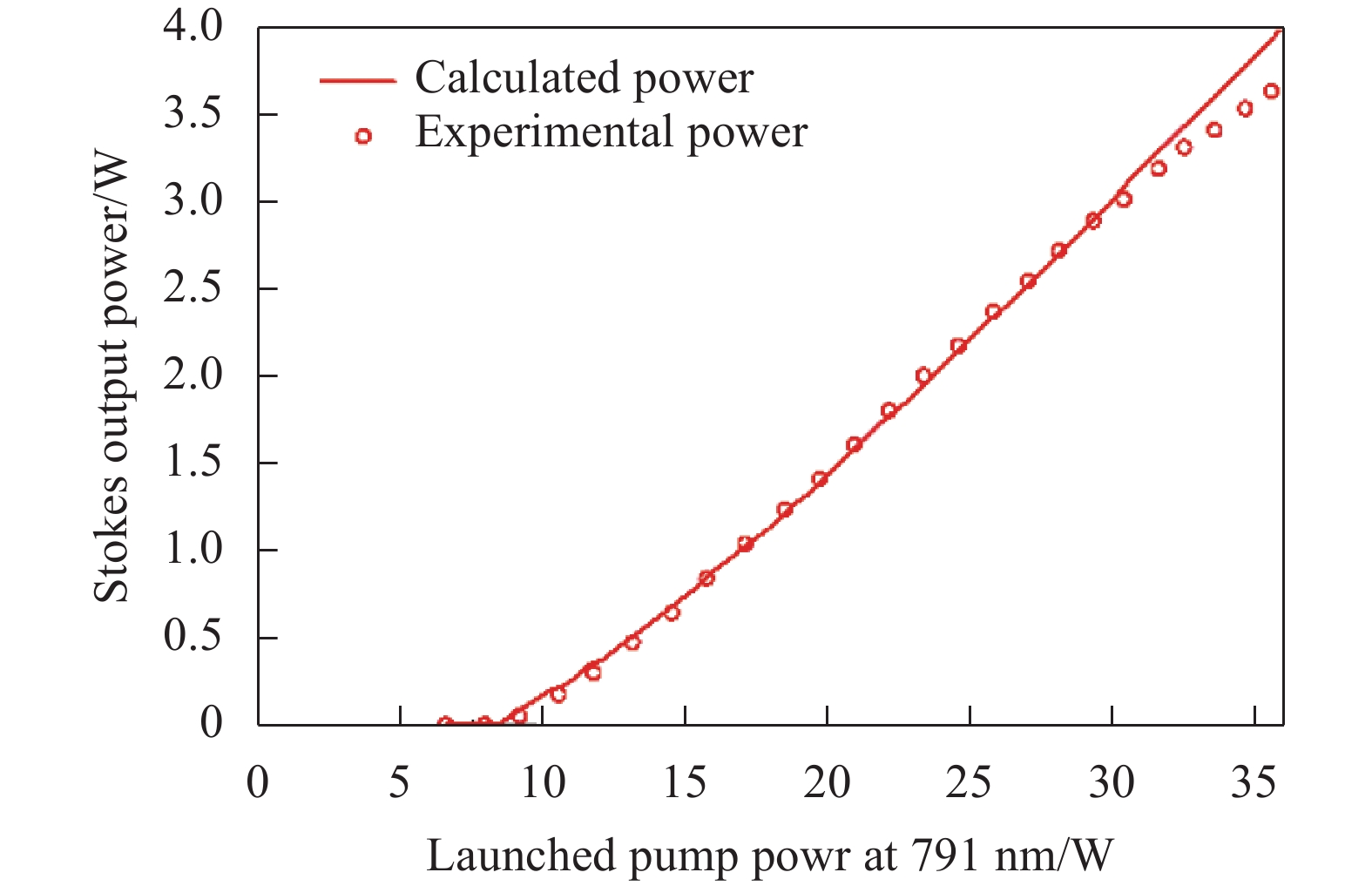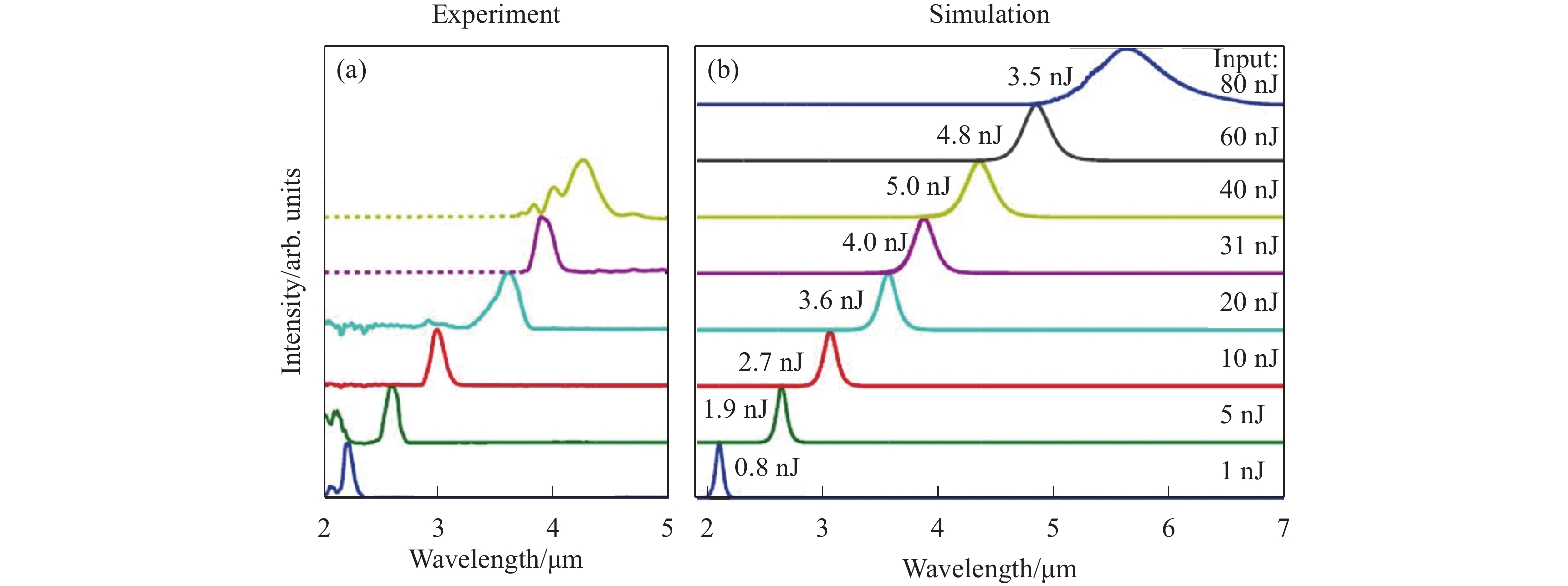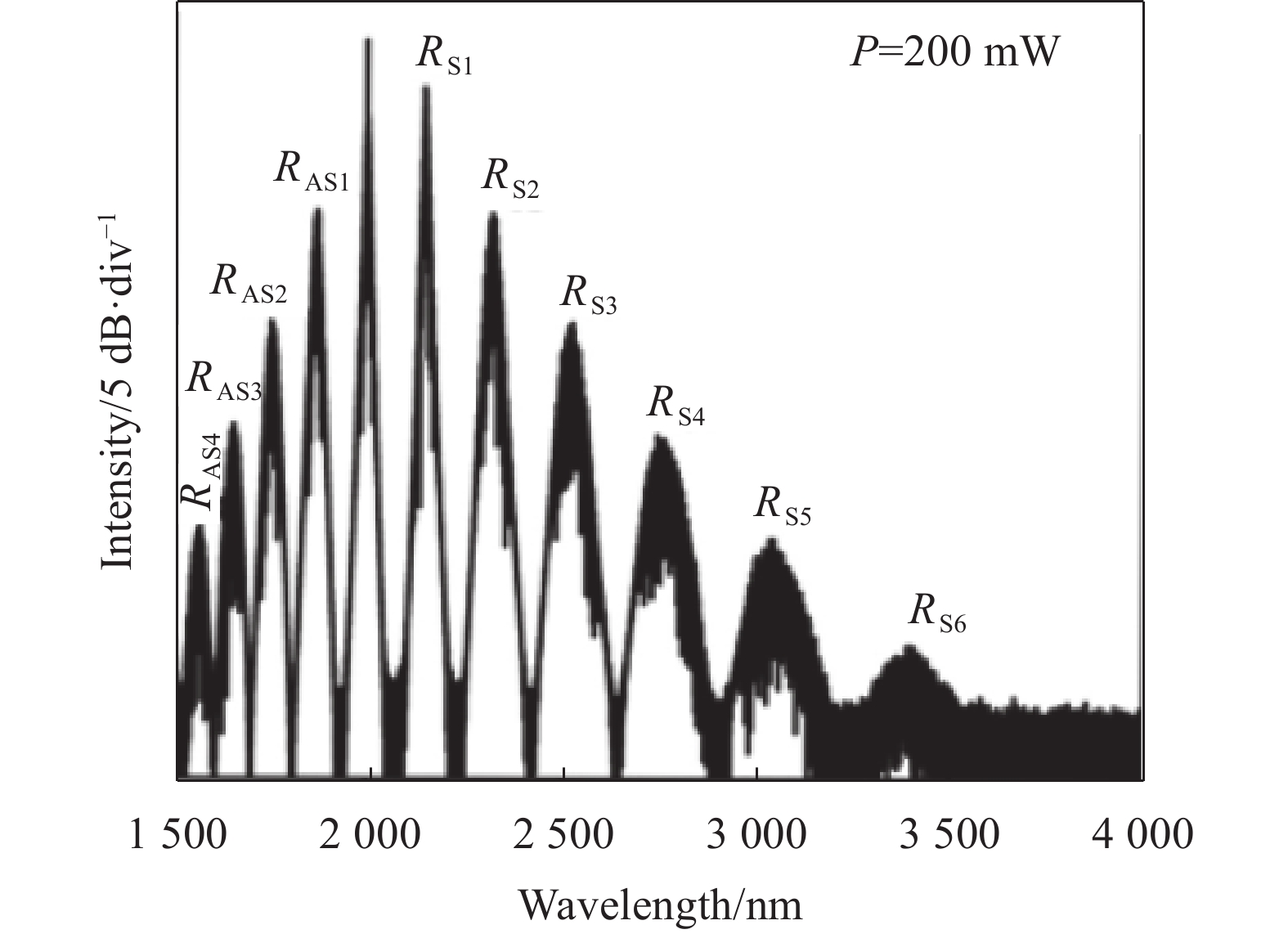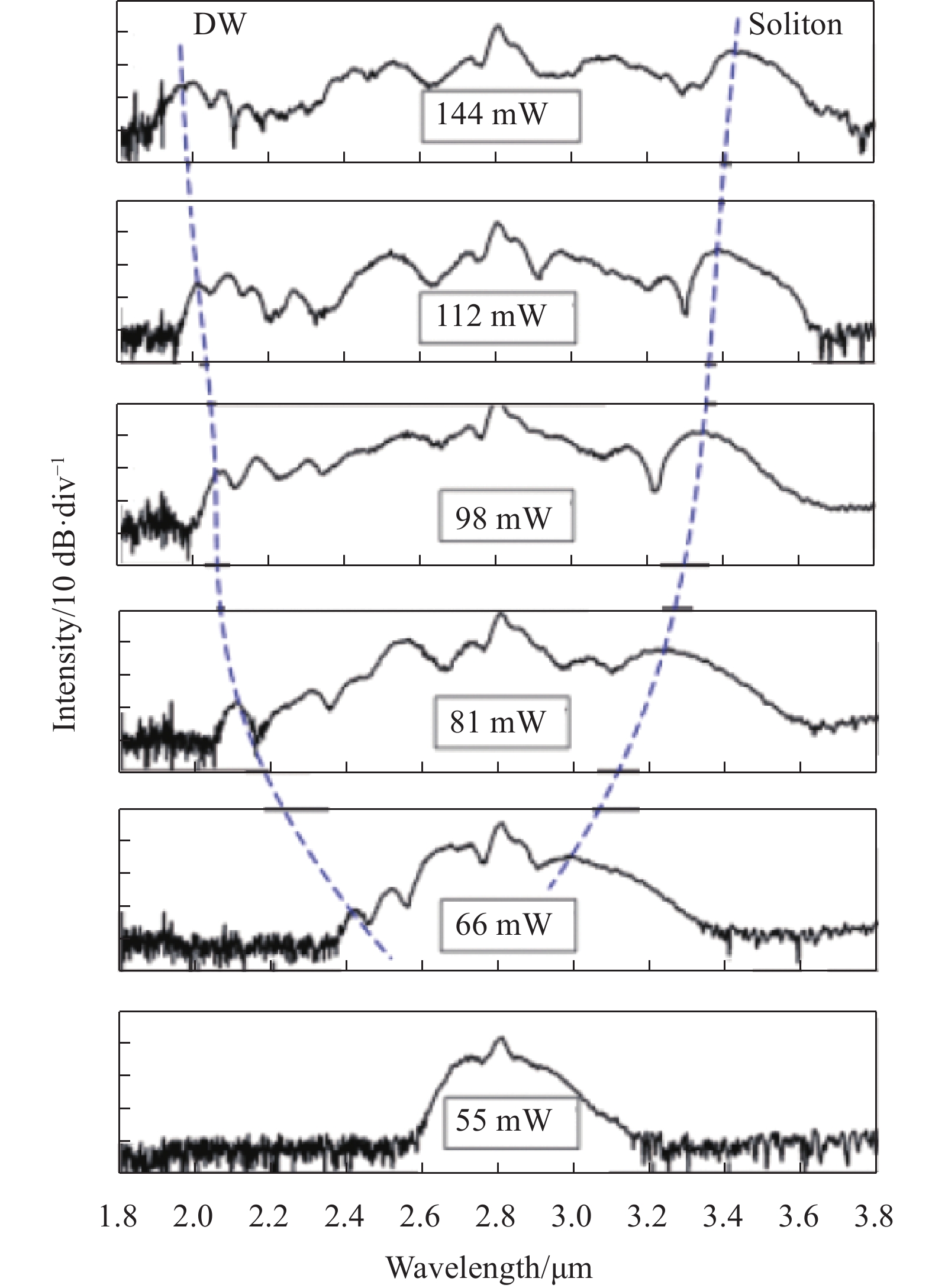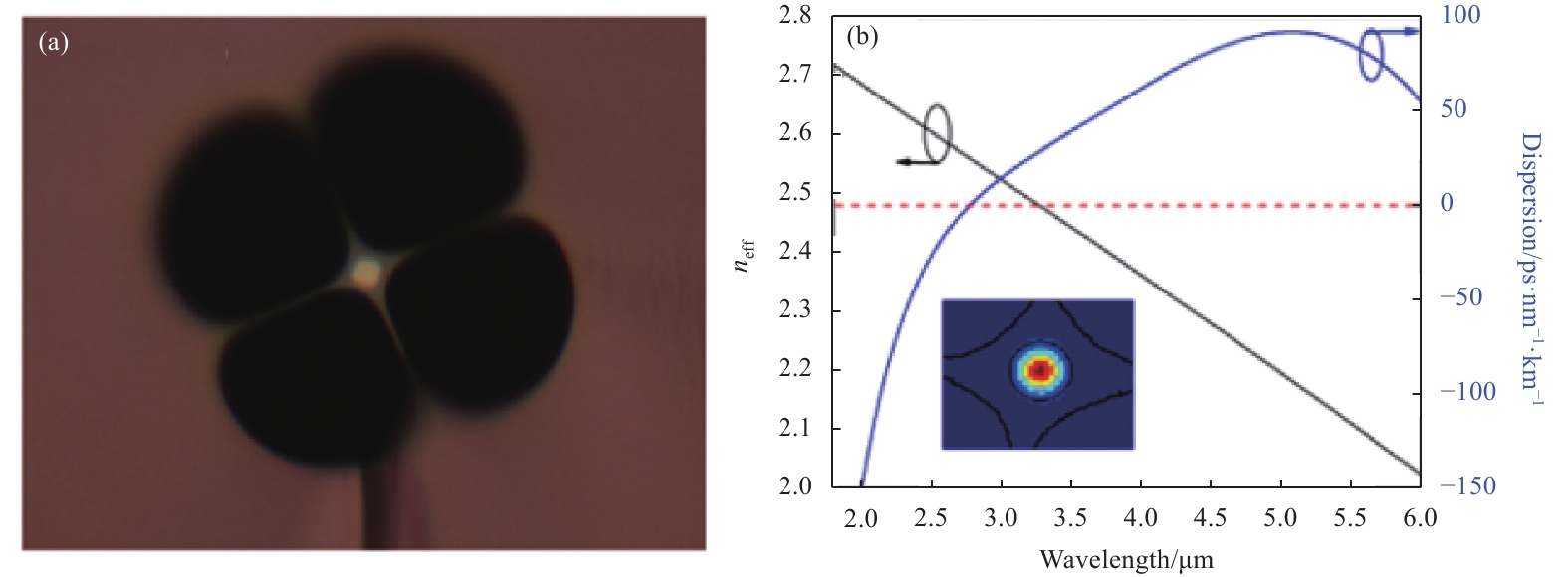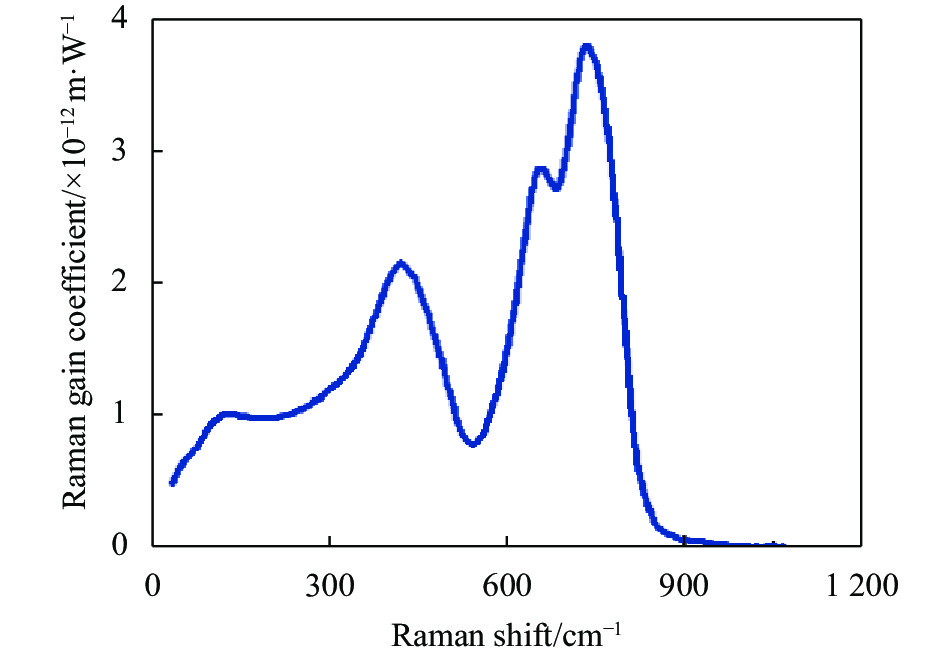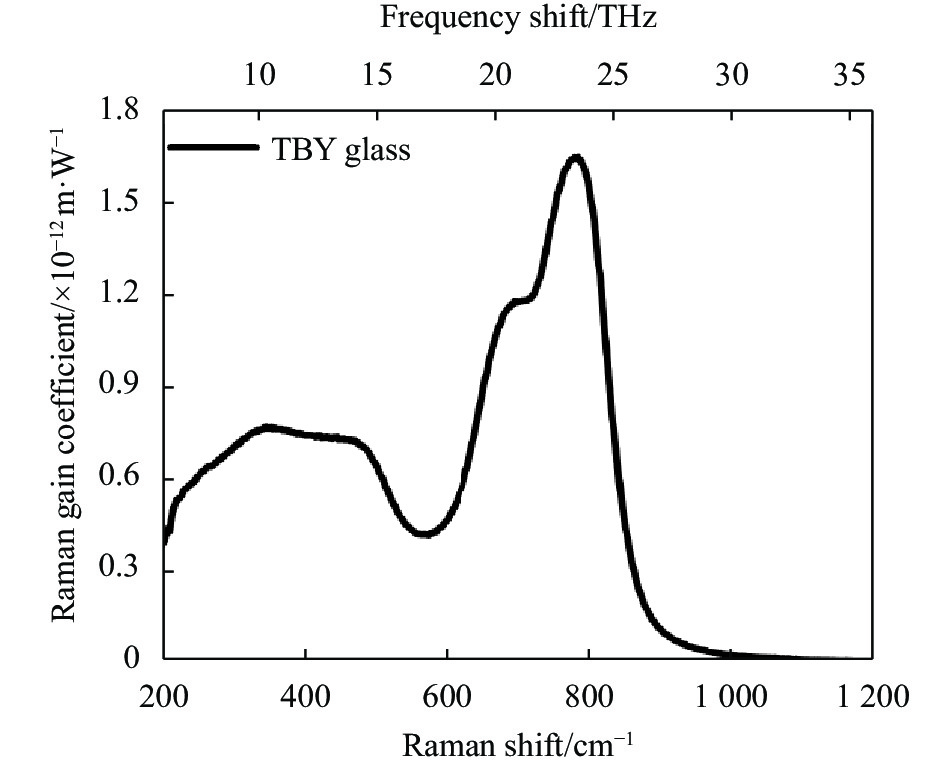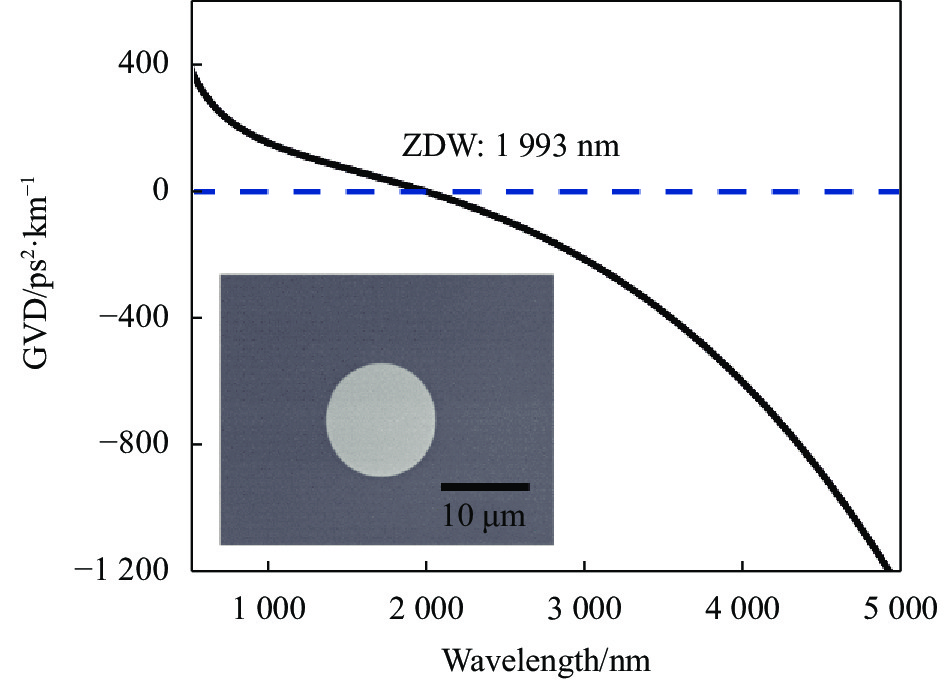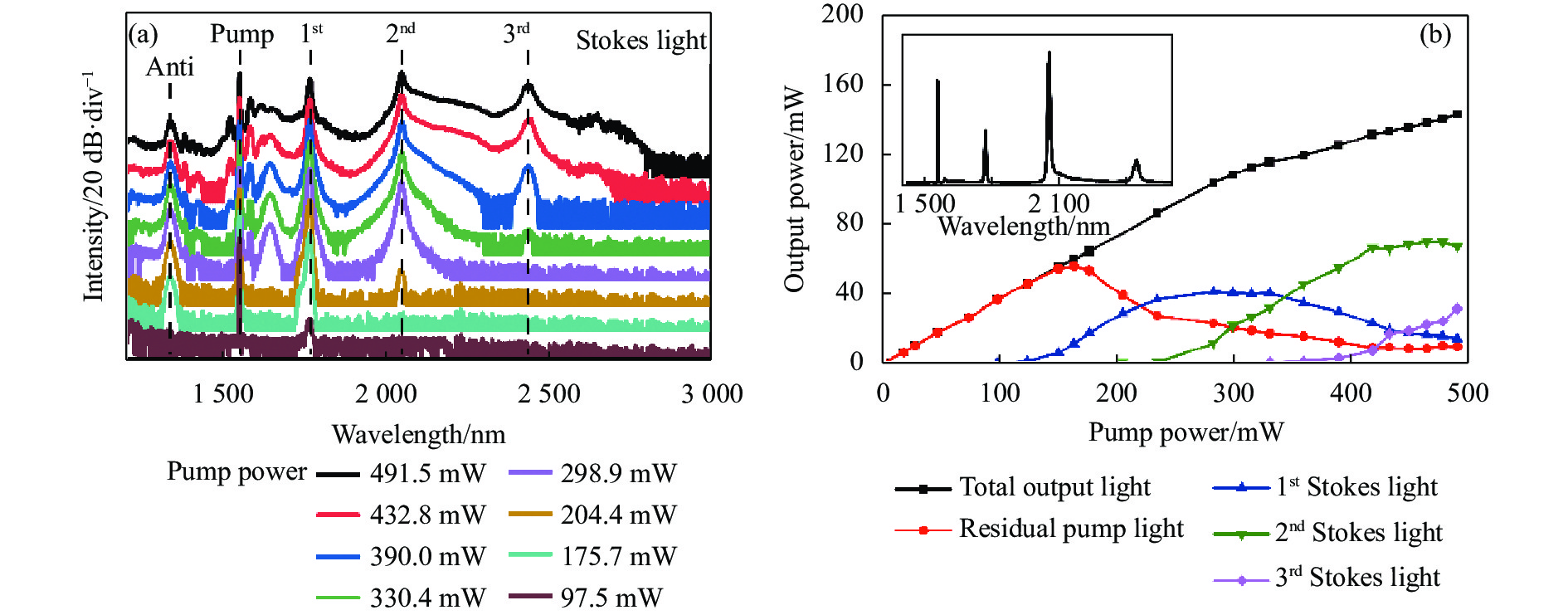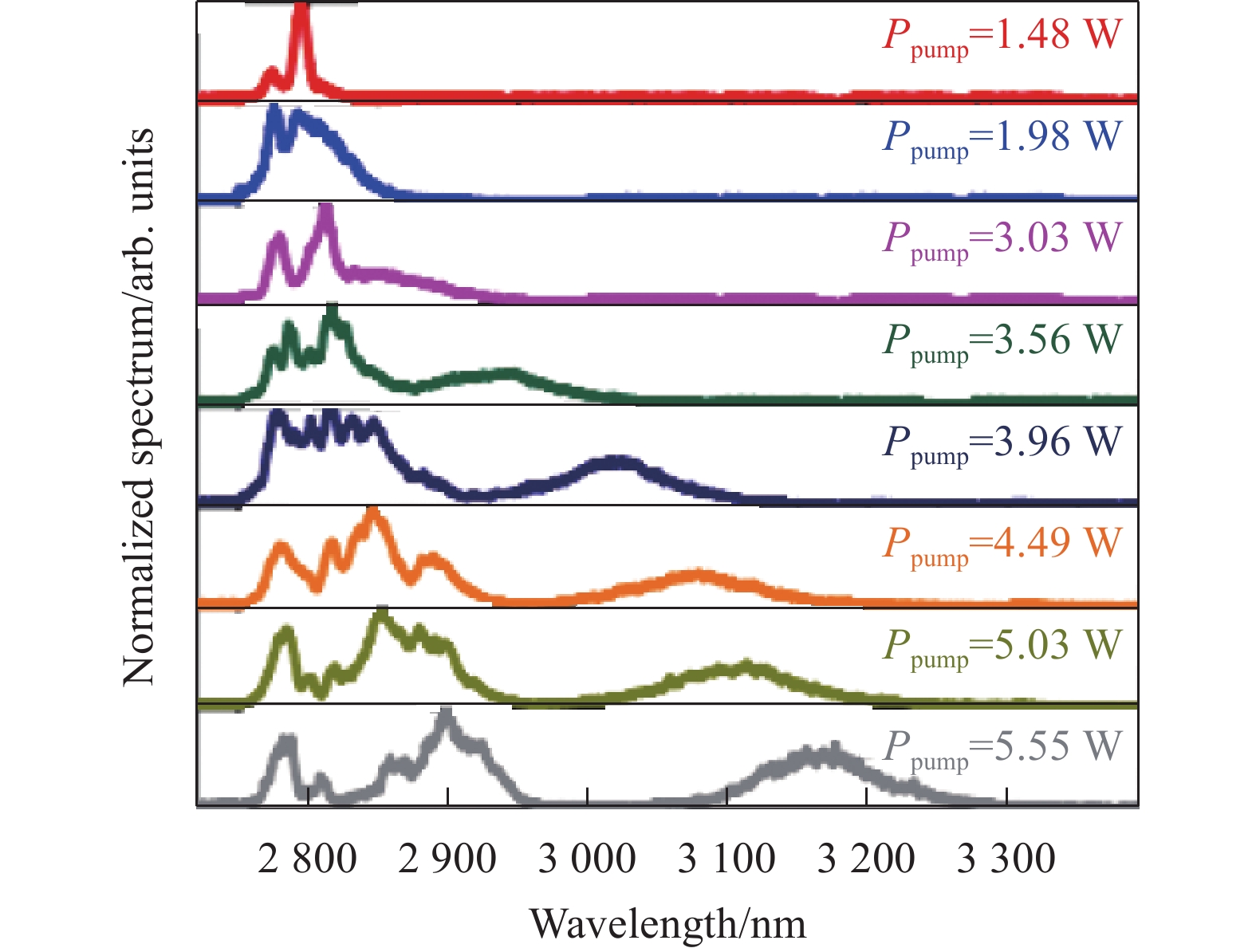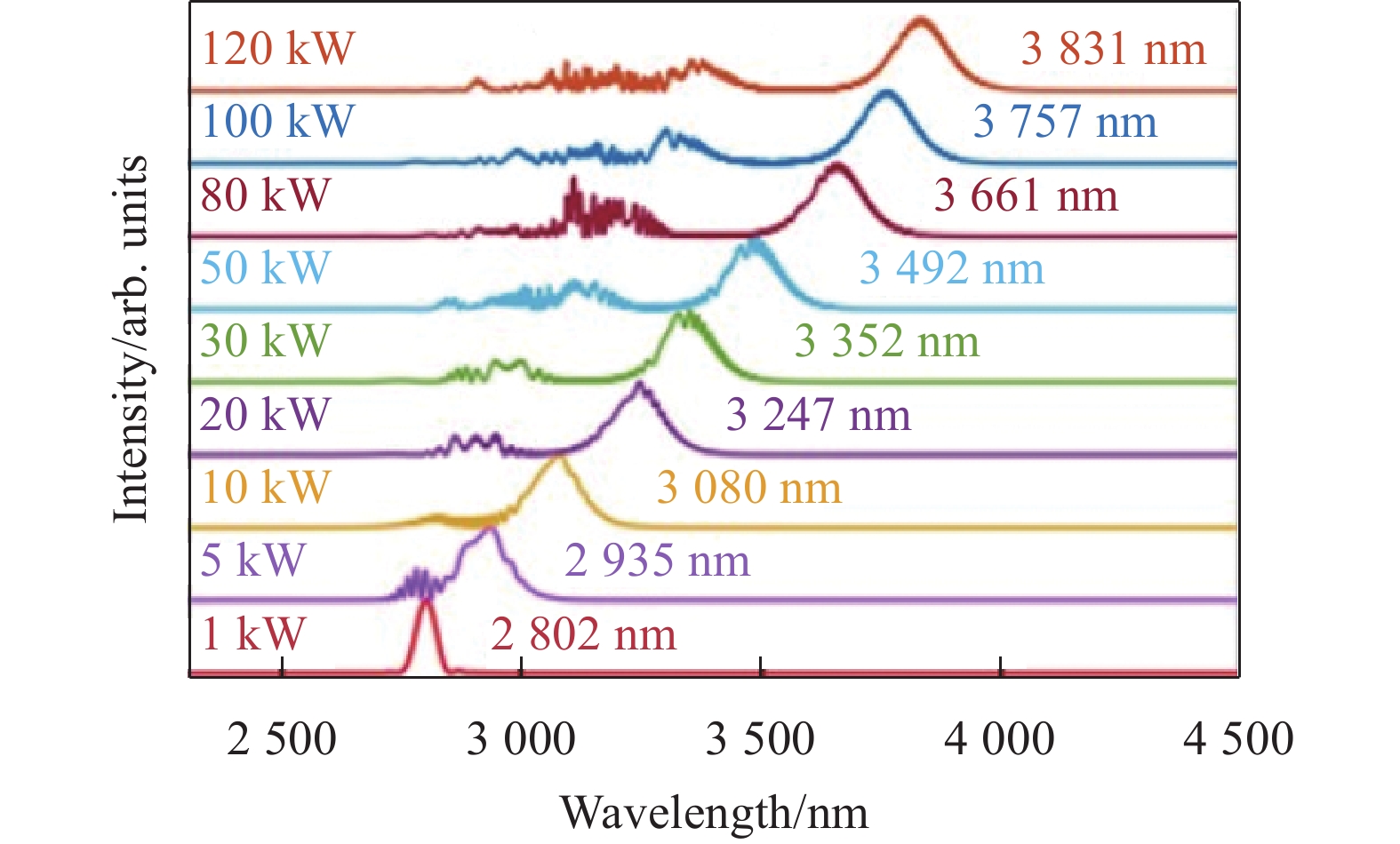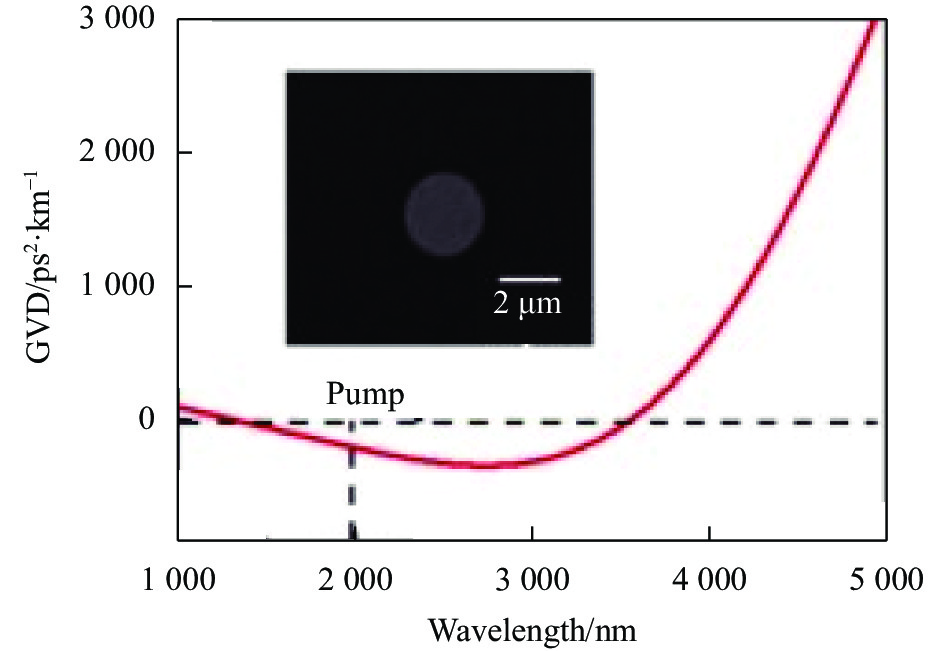-
高功率中红外光纤激光光源在分子光谱学、光通讯、生物医疗、遥感、环境监测以及国防安全等领域有着重要的应用[1-8]。拉曼激光光源是实现中红外激光输出的一种主要技术手段,其是利用光纤中的受激拉曼散射过程实现增益,具有增益谱带宽、可实现级联运转等特点,原则上可在中红外玻璃光纤材料透过窗口范围内实现任意波长激光输出[9]。此外,基于光纤中拉曼孤子自频移效应产生宽调谐范围的拉曼孤子激光是另一种获得中红外波段激光光源的重要方式。当孤子激光(脉冲宽度为~1 ps或更短)在具有负色散的中红外光纤中传输时,在脉冲内拉曼散射效应作用下,拉曼孤子激光脉冲的低频成分被放大,孤子光谱向长波方向移动,获得宽波长调谐范围的中红外拉曼孤子激光输出[9-10]。
作为拉曼光纤激光光源的重要组成部分之一,增益光纤的基质材料选择以及光纤设计与制备对光源的性能有着重要影响。石英、氟化物、硫系、碲酸盐等玻璃光纤是研制拉曼激光光源的几种主要增益介质。表1总结了几种典型玻璃材料的透过窗口和拉曼增益特性[9,11-12]。可以看出,石英玻璃的红外透过窗口窄,这限制了其在中红外波段拉曼激光光源研制方面的应用。而氟化物、硫化物和碲酸盐等玻璃光纤在中红外波段具有相对较宽的透过窗口和较大的拉曼增益系数,是研制中红外拉曼激光光源的主要介质材料。
Glass Transparency window/
μmPeak Raman gain at 2.0 μm/
×10−13 m·W−1Peak Raman shift/
cm−1Nominal Raman gain bandwidth/
cm−1Silica 0.35-2 0.5 442 200 Fluoride 0.22-4.5 0.57-2.1 570 50 Arsenic sulfide (As2S3) 1.5-6.5 21.5-28.5 345 90 Arsenic selenide (As2Se3) 1.5-9.5 100-255 226 60 Tellurite 0.5-4.5 4.5-26 750 140 利用上述几种玻璃光纤作为增益介质,研究者已报道了工作波长位于近红外和中红外波段的拉曼激光光源,如图1所示[13-24]。在近红外波段拉曼激光光源研究方面,利用低损耗石英光纤作为增益介质,已实现平均功率千瓦量级和波长调谐范围覆盖1~2 μm的拉曼激光光源[13-17]。与之相比,中红外波段拉曼激光光源输出功率较低,其工作波长有待进一步向长波区拓展。在基于氟化物玻璃光纤的拉曼激光光源研究方面,Fortin等研制出平均输出功率为3.7 W、工作波长位于2231 nm的拉曼光纤激光器[18]。Tang等利用拉曼孤子自频移技术研制出波长调谐范围覆盖2~4.3 μm的中红外拉曼孤子激光光源[19]。与氟化物玻璃相比,硫系玻璃具有更宽的中红外透过窗口和更大的拉曼增益系数。Barnier等利用硫化砷玻璃光纤作为增益介质,搭建了基于嵌套光栅的两级级联拉曼激光器,实现了工作波长位于3.77 μm的拉曼激光输出,其平均功率为9 mW、峰值功率为112 mW[20]。与上述两种光纤相比,碲酸盐玻璃光纤具有较大的拉曼频移、高的拉曼增益系数和较强的抗激光损伤能力,利用其作为拉曼增益介质有望实现平均功率十瓦量级的3~5 μm拉曼光纤激光器和波长调谐范围覆盖2.8~4.8 μm的中红外拉曼孤子激光光源[21-22]。受当前红外玻璃光纤和超短脉冲泵浦激光光源性能参数的限制,实验上获得的中红外拉曼激光光源的工作波长和调谐范围同理论计算结果还存在较大差距。探索新型中红外玻璃光纤材料,突破低损耗中红外玻璃光纤制备技术,是提高中红外拉曼激光光源输出功率、拓展其工作波长的关键。
近年来,面向高功率中红外激光光源的应用需求,笔者研究团队研制出一种具有宽红外透过窗口、高稳定性、高热机械品质的氟碲酸盐玻璃光纤。利用该光纤作为增益介质,实现了光谱范围覆盖1.5~3.7 μm的级联拉曼散射并搭建了级联拉曼光纤放大器;实现了波长调谐范围覆盖1.98~2.82 μm的拉曼孤子激光光源和工作波长为~4 μm的红移色散波。文中主要介绍了几种中红外玻璃光纤材料的特点及相应的拉曼激光光源的研究进展情况,并对其发展趋势进行了展望。
-
氟化物玻璃光纤具有低的传输损耗、宽的红外低损耗传输窗口,是目前研制中红外拉曼光纤激光器常用的增益介质之一。氟化物玻璃主要包含ZrF4基玻璃、InF3基玻璃和AlF3基玻璃[25],其中以ZBLAN(ZrF4-BaF2-LaF3-AlF3-NaF)为代表的ZrF4基玻璃是目前研究最为成熟的氟化物玻璃。ZBLAN光纤的理论损耗约为0.001~0.010 dB/km,比石英光纤低一个数量级,因而得到了研究者的广泛关注[25]。目前,美、法、日三国均实现了ZBLAN光纤商用化,最低损耗为数十dB/km。相较于ZrF4基光纤,InF3基光纤和AlF3基光纤的研究开展较晚。InF3基玻璃具有较低的声子能量(~510 cm−1),其红外截止带边>8 μm,是获得>4 μm波长激光输出的潜在增益材料[26-29]。AlF3基玻璃红外截止带边为~6 μm,其玻璃转变温度高、化学稳定性好,有望用于实现高功率中红外激光稳定输出。近年来,国内吉林大学、中国科学院上海光学精密机械研究所、哈尔滨工程大学等多个研究单位在氟化物玻璃光纤及应用方面取得了显著进展。其中,吉林大学贾世杰等率先利用自制Ho3+、Ho3+/Pr3+掺杂AlF3/InF3基光纤实现了2868 nm激光输出[30-31],并系统研究了Er3+、Pr3+等稀土离子掺杂氟化物玻璃在2.7~4 μm波段的发光性质[32-33]。中国科学院上海光学精密机械研究所姜益光等在低损耗、高抗损氟化物玻璃光纤研制方面取得了较好进展,成功制备出损耗为50~140 dB/km的ZBLAN多模光纤[23,34-35]。哈尔滨工程大学王顺宾等基于Ho3+/Pr3+共掺AlF3基光纤获得了瓦量级的2.9 μm激光输出[36-37],利用Nd3+敏化Ho3+,在808 nm激光泵浦下观察到了的3.9 μm发光增强现象[38-39]。
图2给出了三种典型氟化物玻璃材料的拉曼光谱[32]。ZrF4基玻璃(如ZBLAN玻璃)的主拉曼频移峰位于570~590 cm−1(17.1~17.7 THz)附近,对应于[ZrF6]八面体、[ZrF8]十二面体中Zr-F键的对称伸缩振动[40-41]。ZrF4基玻璃的最大拉曼增益系数为~7×10−14 m/W@2 μm,高于石英玻璃[42-43]。InF3基玻璃(如IZGC(InF3-ZnF2-GaF3 -BaF2-SrF2-CaF2)玻璃)的主拉曼频移峰位于510 cm−1(15.3 THz)附近[32],AlF3基玻璃(如AYF(AlF3-MgF2-CaF2-SrF2-BaF2-YF3)玻璃)的主拉曼频移峰位于620 cm−1(18.6 THz)附近[32]。
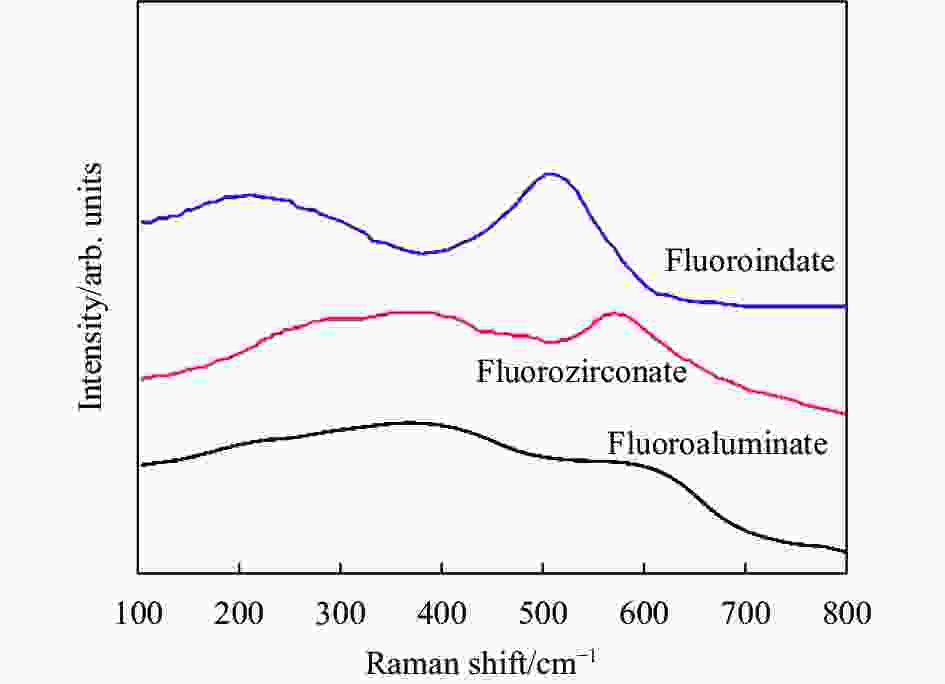
Figure 2. Raman spectra of fluorozirconate, fluoroindate and fluoroaluminate glasses[32]
在光纤中的级联拉曼散射现象研究方面:2017年,日本丰田工业大学Cheng等首次在一段10 m长双折射ZBLAN光纤中观察到了近红外波段的四级级联拉曼散射[44]。实验中所使用的泵浦光源为一台工作波长为1064 nm的皮秒脉冲激光器,其脉冲宽度为~15 ps,重复频率为~80 MHz,输出激光为线偏振光。当泵浦光平均功率达到~7 W且振动方向平行于增益光纤慢轴时,可观察到四级级联拉曼散射,其中心波长分别位于1135、1211、1300、1407 nm。当泵浦光振动方向平行于增益光纤快轴时,只观察到三级级联拉曼散射,这是由于光纤快轴的损耗大于慢轴的原因导致的[44]。
在中红外拉曼光纤激光器方面:2011年,加拿大拉瓦尔大学Fortin等首次报道了基于氟化物玻璃光纤的拉曼激光器[45],其谐振腔由一对直接刻写在氟化物玻璃光纤两端的光纤布拉格光栅(FBG)构成。当1 940 nm泵浦激光功率为7 W、增益光纤长度为29 m时,获得了中心波长为2185 nm、平均功率为0.58 W的拉曼激光输出。随着泵浦功率的增大,斜率效率由29%减小至14%,这可能是由于光纤内积累的热效应引起的输出端FBG反射波长移动以及腔内激光光谱宽化导致的[9,45]。随后,该研究组进一步优化了激光器系统结构,将1 981 nm泵浦激光谐振腔和拉曼激光谐振腔嵌套在一起,如图3所示,该结构可以有效降低激光产生阈值,提高激光器转换效率[18]。为了避免高功率运转时系统热效应带来的影响,实验中还加入了帕尔贴冷却器以保证石英光纤与氟化物玻璃光纤间的耦合效率,引入了带冷却装置的“V”型槽以抑制热效应导致的FBG反射波长红移。该激光器的最大平均输出功率为3.66 W,工作波长为2231 nm。2231 nm拉曼激光输出功率随791 nm泵浦光功率的变化规律如图4所示,其斜率效率为15%。

Figure 3. Experimental setup of nested cavity for 2231 nm Raman laser based on fluoride glass fiber[18]

Figure 4. Output power of 2231 nm Raman laser versus launched pump power[18]
在中红外拉曼孤子激光光源研究方面:2016年,美国康奈尔大学Tang等利用工作波长为1.9 μm、脉冲宽度为70 fs的激光器泵浦一段长度为2 m、芯径为9 μm、零色散波长为1.71 μm的InF3基玻璃光纤,获得了波长连续可调的中红外拉曼孤子激光输出,其波长调谐范围覆盖2.0~4.3 μm,相应脉冲宽度为60~140 fs,峰值功率为20~75 kW[19]。图5给出了基于InF3基玻璃光纤的红移拉曼孤子激光实验结果和数值模拟计算结果。理论计算结果显示,利用该方案有望将拉曼孤子激光的工作波长进一步红移至5.6 μm。为进一步提高基于氟化物玻璃光纤的中红外拉曼孤子激光光源的输出功率,2016年,加拿大拉瓦尔大学Duval等利用工作波长位于中红外波段(2.8 μm)的飞秒激光作为泵浦源,获得了平均输出功率为2.1 W的中红外拉曼孤子激光光源,其波长调谐范围覆盖2.8~3.6 μm, 3.4 μm孤子激光的最大脉冲能量为37 nJ,相应的峰值功率估计可超过200 kW[46]。2019年,德国慕尼黑大学Nagl等利用Cr:ZnS光参量振荡器产生的2.3 μm飞秒激光作为种子源,纤芯直径为6.8 μm的ZBLAN光纤作为增益介质,实现了调谐波长范围覆盖2.3~3.85 μm的中红外拉曼孤子激光,其中在3.85 μm孤子激光的最大脉冲能量为2.4 nJ,脉冲宽度为70 fs,平均输出功率为112 mW[47]。2021年,法国利摩日大学Tiliouine等利用大模场ZBLAN光纤作为增益介质,实现了调谐波长范围覆盖2.39~3.17 μm的中红外拉曼孤子激光[48],其实验装置如图6所示,实验中采用脉冲宽度为765 fs、脉冲能量为1 μJ的1965 nm激光泵浦一段大模场石英光纤和一段大模场ZBLAN光纤。泵浦脉冲首先在40 cm长石英光纤中产生中心波长频移至2390 nm的拉曼孤子,随后该孤子同残余泵浦光直接耦合进入3.5 m长的ZBLAN光纤。拉曼孤子在ZBLAN光纤中实现进一步的波长频移,其中心波长最终频移至3170 nm,孤子光源的脉冲宽度为165 fs,脉冲能量为45 nJ,峰值功率为273 kW,如图7所示。
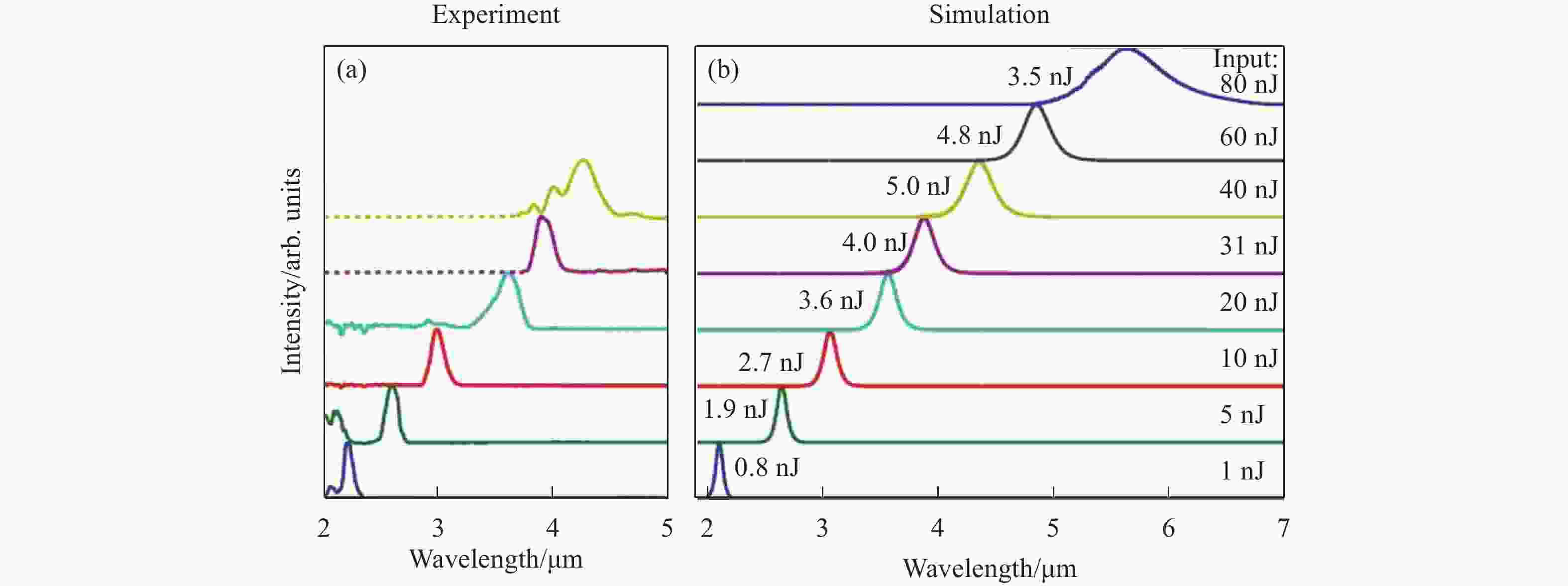
Figure 5. Spectra of tunable Raman soliton based on InF3 glass fiber[19]. (a) Experimental measurement results; (b) Numerical simulation results

Figure 6. Experimental setup for generation of mid-infrared Raman soliton in fluoride fiber[48]
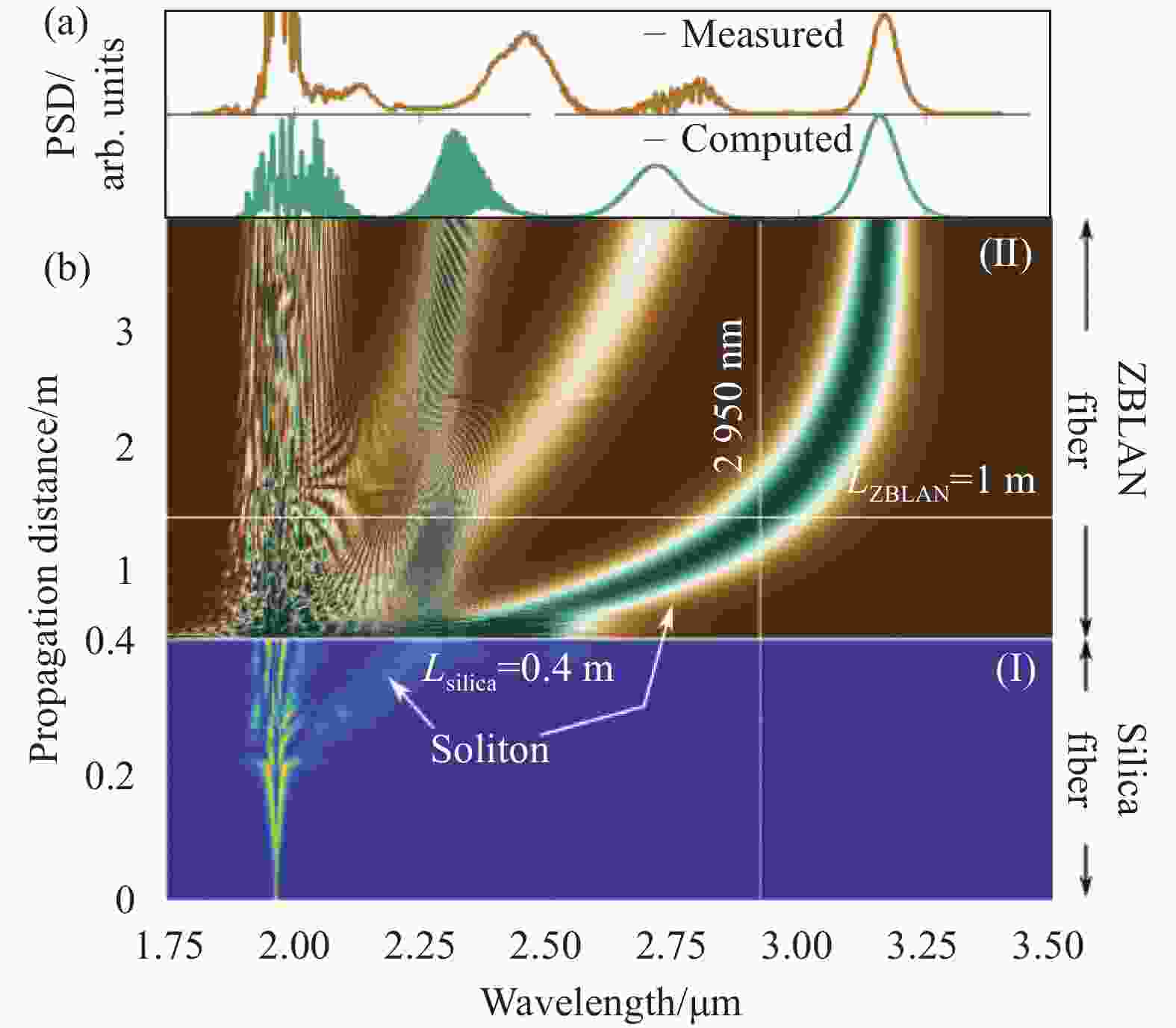
Figure 7. Spectra of Raman soliton from 2.39 to 3.17 μm. (a) Comparison between measured and computed spectral profiles; (b) Numerical simulation of the evolution of the spectrum along the 40 cm silica fiber followed by the 3.5 m ZBLAN fiber[48]
与ZBLAN和InF3基玻璃相比,AlF3基玻璃具有更优异的抗潮解性能和抗激光损伤性能,研究者常采用增加AlF3基玻璃光纤保护端帽的方式来实现提高中红外激光光源的输出功率和稳定性[49-50]。未来,利用低损耗AlF3基玻璃光纤有望进一步提升中红外激光光源输出功率。
-
与氟化物玻璃相比,硫系玻璃具有更宽的红外透过窗口(1~25 μm)。硫系玻璃是以硫(S)、硒(Se)、碲(Te)等硫系元素为主体,结合一种或几种其他类金属元素(如锗、砷、锑等)形成的一种中红外玻璃材料,其具有极低的声子能量(300~450 cm−1)、高的折射率(2.0~3.5)、高的非线性折射率((2~20)
$ \times $ 10−18 m2/W,比石英玻璃高两三个数量级)、超短的非线性响应时间(<200 fs)[51]。目前,商品化的硫系玻璃光纤有As2S3和As2Se3光纤,其最低损耗分别为~0.05 dB/m和0.20 dB/m,其性能参数如表2所示[52-54]。中国科学院西安光学精密机械研究所、宁波大学、江苏师范大学等多个国内研究单位围绕低损耗硫系玻璃光纤开展了系列研究工作[55-60]。其中,中国科学院西安光学精密机械研究所郭海涛研究团队采用反复蒸馏提纯和开放式动态蒸馏相结合的工艺成功制备出高纯As-S和高纯Ge-Sb-Se等多种硫系玻璃,并发展了高温真空高速旋转预制棒成型和超窄光纤拉丝温控等关键技术,成功制备出As2S3、As2Se3、Ge-Sb-Se、Ge-Ga-S-Cds(CdI2)等多种硫化物玻璃光纤, As2S3光纤的最低损耗为0.2 dB/m@3.8 μm,Ge-Sb-Se光纤的最低损耗为2.2 dB/m@7.0 μm[59-60]。Index CoreActive IRFlex Art Photonics P/N IRT-SU IRT-SE IRF-S IRF-Se IRF-SeG CIR Core/clad As2S3 As2Se3 As2S3 As2Se3 As2Se3/GeAs2S3 As2S3 Transmission range/μm 2-6 2-9 1.5-6.5 1.5-10 1.5-9.3 1.1-6.5 Core refractibe index 2.4 2.7 2.4 2.7 2.7 2.42 Numerical aperture 0.25 0.26 0.28-0.30 0.275-0.350 0.76 0.25-0.30 Typical loss/dB·m−1 0.15@2.7 μm
0.70@4.0 μm0.20@6 μm
0.50@4.55 μm0.05@2.8 μm 0.21@2.59 μm 0.32@2 μm 0.20@2.5-4 μm Tensile strength/kpsi >15 >15 >15 >15 - >70 另外,硫系玻璃还具有极大的拉曼增益系数,其拉曼增益系数比石英玻璃高两三个数量级。典型As2S3玻璃的最大拉曼增益系数为3.75
$ \times $ 10−12 m/W@2 μm,峰值拉曼频移为350 cm−1,对应于[AsS3/2]正棱锥的对称伸缩振动。As2Se3玻璃的最大拉曼增益系数为2.55$ \times $ 10−11 m/W@2 μm,峰值拉曼频移为250 cm−1,对应于As-Se键的振动[61]。在光纤中的级联拉曼散射现象研究方面: 2011年,法国宇航院Duhant等利用一段长度为1.7 m的As-Se微结构光纤作为非线性介质,观察到了四级级联拉曼散射[62]。实验中泵浦光源为工作波长位于1 995 nm的纳秒光纤激光器,当其峰值功率达到11 W时,产生了波长位于2450 nm的四级斯托克斯光。2018年,日本丰田工业大学Cheng等首次报道了基于硫化物玻璃光纤的八级级联拉曼散射,这是在非石英光纤中获得的级联数目最多的拉曼散射现象[63]。实验中所选用的增益光纤为一段基于As38S62和As36S64玻璃的As-S光纤,其长度为16 m,泵浦光源为工作波长为1545 nm的纳秒光纤激光器,其脉冲宽度为~4.1 ns,重复频率为~25 kHz。当平均泵浦功率为100 mW时,获得了波长位于~2698 nm的八级斯托克斯光。2021年,东北大学Wang等采用脉冲宽度为~20 ns、重复频率为~10 kHz的2 μm纳秒激光泵浦一段长度为8 m、纤芯直径为~5.0 μm的自制As2S5玻璃光纤,获得了六级级联拉曼散射,其实验结果如图8所示,最长输出波长位于3.43 μm[64]。
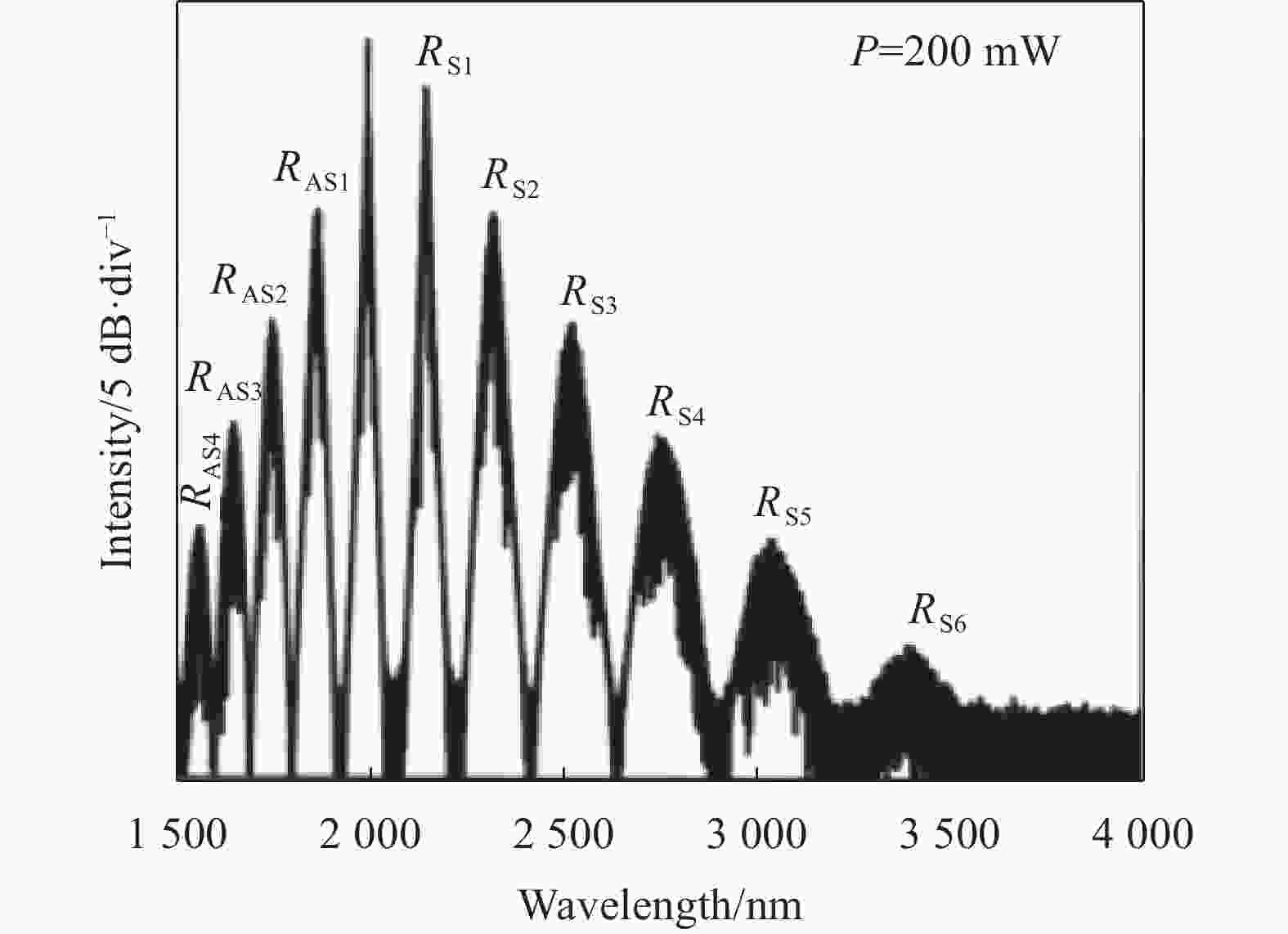
Figure 8. Cascaded Raman shift spectra of 8 m long As-S optical fiber[64]
在中红外拉曼光纤激光器研究方面:2006年,澳大利亚悉尼大学Jackson等首次报道了基于As2S3玻璃光纤的拉曼激光器,其输出波长依次为2062、2102、2166 nm,对应的输出功率分别为0.64、0.2、0.016 W[65]。该研究工作中的谐振腔由一个宽带反射镜和反射率为22%的光纤端面构成。随着中红外FBG制备技术和~3 μm波段泵浦源(例如掺铒氟化物光纤激光器)的发展,中红外拉曼光纤激光器的性能也取得了较大提升。2012年,加拿大拉瓦尔大学的Bernier等通过相位掩膜法成功制备出硫化物玻璃光纤光栅[66]。次年,该团队报道了基于硫化物玻璃光纤的第一台工作波长>3 μm的拉曼激光器[67]。实验中所选用的泵浦光源为一台输出波长位于3.005 μm的准连续掺Er3+氟化物玻璃光纤激光器,其脉冲宽度为5 ms,重复频率为20 Hz,所选用的增益介质为一段长度为3 m、芯径为4 μm的As2S3玻璃光纤。实验中,谐振腔由直接刻写在As2S3玻璃光纤两端的FBG构成,其反射率分别为>99%和63%,获得的拉曼激光工作波长为3.34 μm,平均输出功率为47 mW,相应的峰值功率为0.6 W,斜率效率为39%。2014年,Bernier等进一步实现了工作波长位于3.77 μm的拉曼激光输出,这是迄今为止在拉曼光纤激光器中获得的最长波长,其实验装置如图9所示[20],泵浦源为输出波长位于3.005 μm的准连续掺Er3+氟化物玻璃光纤激光器,增益介质为一段2.8 m长As2S3玻璃光纤,谐振腔由两对嵌套刻写在平均功率为9 mW、峰值功率为112 mW的增益光纤两端的FBG构成。当泵浦光功率为3.9 W、输出端FBG反射率为80%时,获得了3.766 μm拉曼激光输出,激光斜率效率为8.3%,如图10所示。为了获得更长波长的拉曼光纤激光器,2019年,宁波大学Peng等理论计算了基于硫化物玻璃光纤的4.3 μm拉曼激光器性能,结果表明,通过优化光纤长度和FBG反射率有望获得输出功率为0.269 W的4.3 μm拉曼激光[68],但目前作为泵浦光源的~3.9 μm掺钬氟化物光纤激光器研制尚不成熟,>4.0 μm的拉曼激光器尚未见报道。

Figure 9. Experimental setup of 3.77 μm As2S3-based cascaded RFL[20]
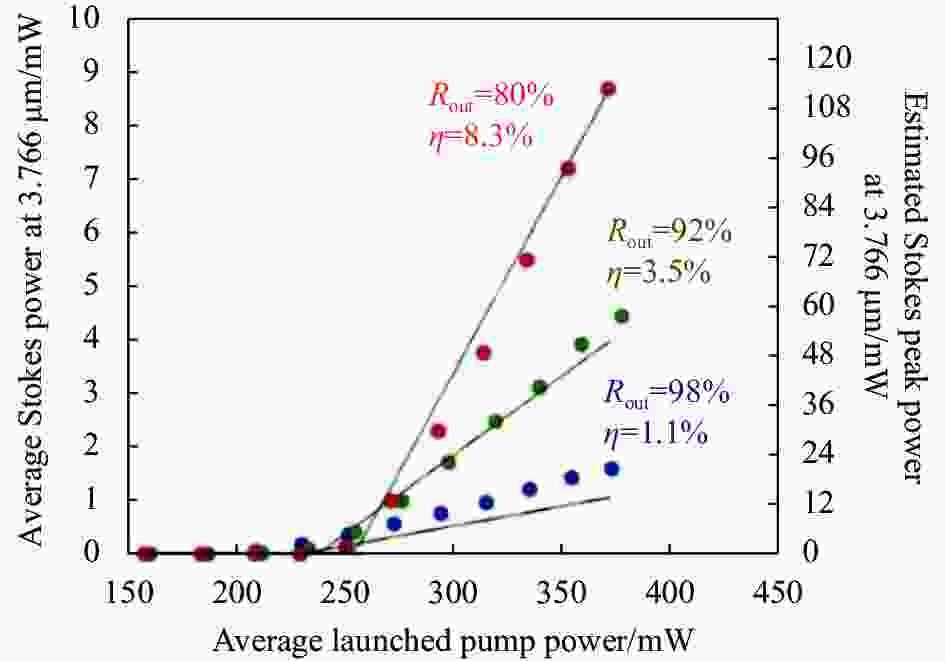
Figure 10. The output power of 3.77 μm Raman laser versus launched pump power for output cascaded Stokes FBG with peak refluctivity of 98%, 92%, and 80%[20]
在中红外拉曼孤子激光光源的研究方面:由于传统的阶跃型硫系玻璃光纤的零色散波长一般大于2 μm (As2S3和As2Se3玻璃材料的零色散波长分别为4.89和7.22 μm),为了获得基于硫系玻璃光纤的中红外拉曼孤子激光光源,研究者通常采用零色散波长位于2 μm附近的硫系微结构光纤作为增益介质。2014年,日本丰田工业大学Cheng等利用拉锥As2S5微结构光纤(零色散波长由2.02 μm逐渐移动至1.61 μm)作为增益介质,利用脉冲宽度为200 fs、重复频率为80 MHz的1 900 nm激光作为泵浦光源,获得了调谐波长范围覆盖2.206~2.800 μm的拉曼孤子激光光源[69]。随后,该研究组利用AsSe2-As2S5微结构光纤作为增益介质,利用脉冲宽度为~200 fs、重复频率为80 MHz的2.8 μm激光作为泵浦光源,获得了调谐波长范围覆盖2.916~3.489 μm的中红外拉曼孤子激光光源,实验结果如图11所示[70]。实验中所使用的AsSe2-As2S5微结构光纤的截面如图12(a)所示,色散曲线如图12(b)所示,其零色散波长位于2.759 μm。最终获得的中红外拉曼孤子激光光源功率较低,仅为毫瓦量级。2022年,电子科技大学Hou等分别对4.1 μm和5.2 μm激光泵浦条件下AsSe2-As2S5光纤产生宽调谐拉曼孤子激光进行了数值模拟[23]。计算结果显示,利用硫系玻璃光纤作为非线性介质,有望获得工作波长>8 μm的拉曼孤子激光光源,如图13所示。

Figure 11. (a) Cross section of the AsSe2-As2S3 MOF[70]; (b) Black line is the fundamental model refractive index and blue line is the calculated group velocity dispersion of the AsSe2-As2S3 MOF
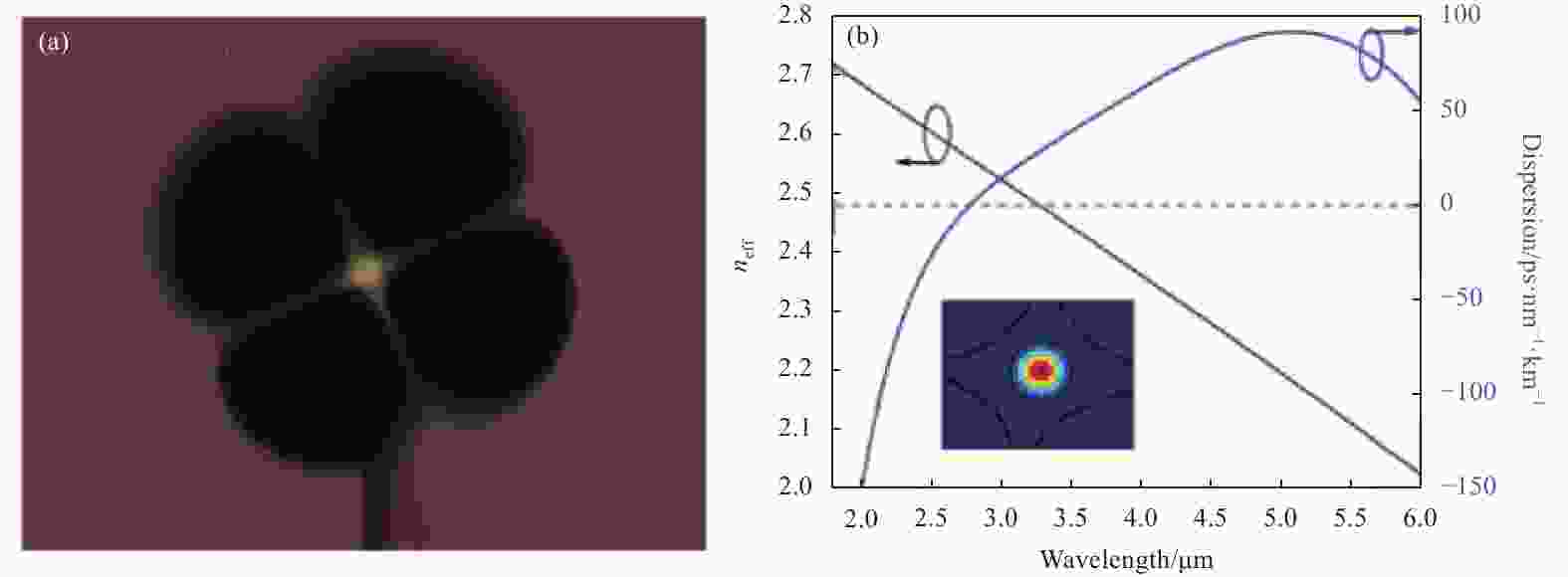
Figure 12. MID-IR SSFS and DW spectra at the pump wavelength of ~2.8 μm with the average pump powers of 55, 66, 81, 98, 112, and 144 mW[70]

Figure 13. The calculated output spectra of the AsSe2-As2S5 fiber with a core diameter ranging from 4.5 μm to 6.5 μm[23]. (a) Use the 4.1 μm pump; (b) Use the 5.2 μm pump
目前已报道基于硫系玻璃光纤的拉曼激光光源均采用As2S3或As2Se3玻璃光纤作为增益介质。由于As元素毒性较高,在光纤制备、测试及使用等过程中,该类玻璃光纤存在一定安全隐患。因此,新型无As环保型硫化物玻璃光纤材料(如Ge-Sb-Se系统硫化物玻璃等)的探索及其在中红外拉曼激光光源方面的应用成为该领域的重要研究方向之一。此外,硫系玻璃光纤的激光损伤阈值较低,严重限制了相关激光输出功率的进一步提升。探索稳定性好、抗激光损伤能力强的新型红外玻璃光纤材料,对推进高功率中红外拉曼激光光源的发展及应用具有重要意义。
-
与氟化物和硫系物玻璃相比,碲酸盐玻璃具有稳定性好、玻璃转变温度高等特点,是另一种研制中红外拉曼激光光源的光纤基质材料。碲酸盐玻璃是以TeO2为主要材料,结合多种其他组分(如Na2O、ZnO、BaO、Bi2O3等碱金属氧化物)形成的氧化物玻璃。碲酸盐玻璃的声子能量约为640~790 cm−1,红外透过窗口覆盖0.4~6.5 μm[71-72]。此外,碲酸盐玻璃还具有较高的非线性折射率(2
$ \times $ 10−18 m2/W)、良好的抗析晶能力、强的抗潮解能力和抗腐蚀性能。近年来,研究者通过控制反应气氛和引入氟化物等方式来去除碲酸盐玻璃中的羟基以提升碲酸盐玻璃光纤的质量[73-74]。目前,利用碲酸盐玻璃光纤作为增益介质,已实现高功率稀土掺杂中红外光纤激光器、中红外超连续激光光源等[74-76]。此外,碲酸盐玻璃具有相比于氟化物玻璃和硫化物玻璃更大的拉曼频移,其拉曼增益系数比氟化物玻璃高一个数量级[9]。碲酸盐玻璃通常具有多个拉曼频移峰,其中,位于750 cm−1 附近的主拉曼频移峰对应于[TeO3]三方锥、[TeO3+1]多面体中非桥氧Te-O-或Te=O键的对称伸缩振动,位于665 cm−1附近的拉曼频移峰对应于[TeO4]三角双锥的反对称伸缩振动,位于400 cm−1附近的拉曼频移峰对应于[TeO3]三方锥、[TeO3+1]多面体以及[TeO4]三角双锥中桥氧Te-O-Te键的对称伸缩振动[77-78]。图14给出了TBZN(TeO2-Bi2O3-ZnO-Na2O)玻璃的拉曼增益光谱,其峰值拉曼频移位于~740 cm−1(~22 THz),相应的拉曼增益系数约为3.8
$ \times $ 10−12 m/W@798 nm,比石英和氟化物玻璃高一个数量级[79]。碲酸盐玻璃在~1 μm皮秒激光泵浦下的损伤阈值为100 GW·cm−2,远大于硫化物玻璃[9,41]。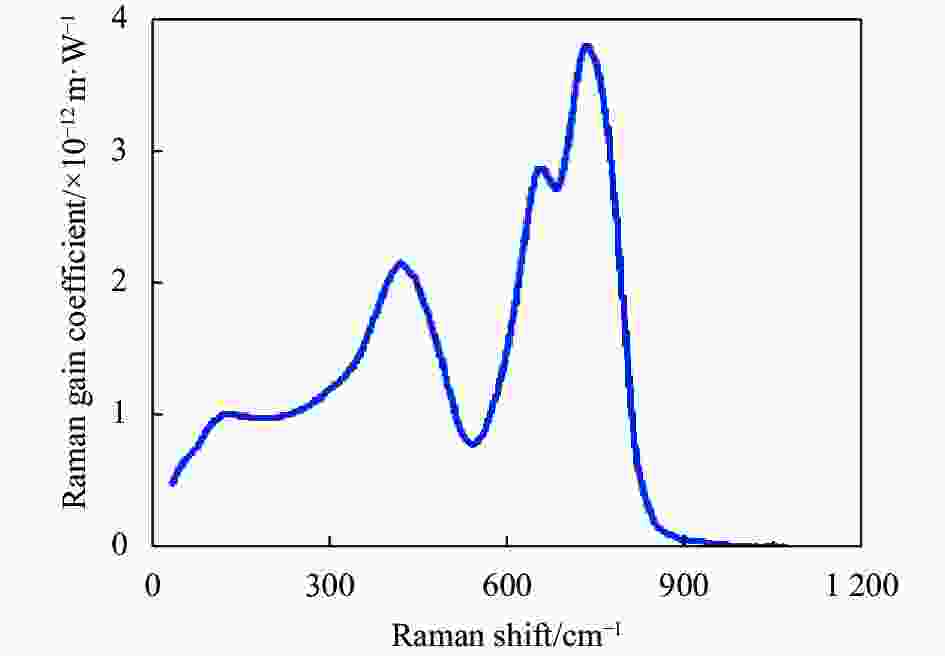
Figure 14. Raman gain coefficient profiles of TBZN glass[79]
在光纤中的级联拉曼散射现象研究方面:2011年,日本丰田工业大学Liao等在拉锥碲酸盐微结构光纤中观察到了五级级联拉曼散射,受到自相位调制、交叉相位调制等非线性效应的影响,其输出光谱为包含五个拉曼斯托克斯峰的超连续光谱,其光谱覆盖730~1700 nm[80]。2022年,日本丰田工业大学Cheng等采用工作波长为1545 nm的纳秒激光作为泵浦光源,2.5 m长的碲酸盐微结构光纤作为拉曼增益介质,在级联拉曼散射效应和四波混频效应的共同作用下,获得了中红外波段激光输出[81]。
在拉曼光纤激光器方面:2008年,日本丰田工业大学Qin等利用碲酸盐玻璃光纤作为拉曼增益介质,研制出工作波长调谐范围覆盖1495~1600 nm (带宽>100 nm)的拉曼光纤激光器[82]。2015年,美国亚利桑那大学Zhu等在理论上研究了碲酸盐玻璃光纤和泵浦激光参数对中红外波段拉曼激光器性能的影响,结果表明,利用碲酸盐玻璃光纤有望获得输出功率为十瓦量级的2~5 μm中红外拉曼激光[21]。
在中红外拉曼孤子激光光源研制方面: 2012年,吉林大学Liu等在纤芯直径为1.1 μm的碲酸盐微结构光纤中实现了波长调谐范围覆盖1.6~2.2 μm的拉曼孤子激光光源[83]。2016年,中国科学院上海光学精密机械研究所Bi等采用1 958 nm皮秒脉冲激光泵浦碲酸盐微结构光纤,研制出波长调谐范围覆盖1 990~2264 nm的拉曼孤子激光光源,所获得的孤子激光脉冲宽度为~40 fs[84]。2015年,日本丰田工业大学Zhang等利用双折射碲酸盐微结构光纤作为增益介质,搭建了中红外拉曼孤子激光器。当泵浦光激发光纤快轴时,获得了波长调谐范围覆盖2 050~2730 nm的多孤子激光光源[85]。同年,俄罗斯科学院应用物理研究所Koptev等利用2 μm掺铥飞秒光纤激光器作为泵浦源,利用碲酸盐微结构光纤作为增益介质,获得了调谐波长覆盖2.1~2.65 μm的拉曼孤子激光光源[86]。2020年,该团队Anashkina等数值模拟了基于碲酸盐微结构光纤的中红外拉曼孤子产生[22]。计算结果表明,利用2.8 μm激光泵浦碲酸盐玻璃光纤,可以获得波长调谐范围覆盖2.8~4.8 μm的中红外拉曼孤子激光光源,如图15所示。

Figure 15. Simulated evolution of Raman soliton during propagation in tellurate microstructure fibers[22]
最近,笔者研究组研制出一种具有高稳定性的氟碲酸盐玻璃(70TeO2-20BaF2-10Y2O3,TBY),该玻璃的透过窗口覆盖0.4~5.5 μm,玻璃转变温度为425 ℃,高于目前所报道的氟化物、硫化物以及碲酸盐玻璃,同时该玻璃还具有良好的抗潮解性能和抗激光损伤特性[74,87]。目前,基于该种玻璃光纤已实现可长期稳定运转的25.8 W全光纤中红外超连续光源[88]。为了探索其在拉曼激光光源研制方面的应用潜力,对上述氟碲酸盐玻璃光纤中的拉曼散射特性开展了系列研究。首先,采用比较法计算了该种玻璃在1550 nm激光泵浦下的拉曼增益谱,如图16所示[89]。TBY玻璃的峰值拉曼频移位于785 cm−1(23.5 THz),相应的拉曼增益系数为1.65
$ \times $ 10−12 m/W @1550 nm,约为石英玻璃的25.4倍。
Figure 16. Raman gain spectrum of TBY glass[89]
验证上述氟碲酸盐玻璃光纤在拉曼激光器方面的应用潜力,笔者研究组设计并制备了具有芯径为~13 μm的氟碲酸盐玻璃光纤。图17中的插图给出了该光纤截面的扫描电镜照片,其零色散波长位于1 993 nm,非线性系数为21.37 km−1W−1。采用回切法测得该光纤在1550 nm处的传输损耗为0.78 dB/m[89]。

Figure 17. Group velocity dispersion curve of fluorotellurite fibers. Inset: cross-sectional scanning electron micrograph of fluorotellurite fibers[89]
利用上述氟碲酸盐玻璃光纤作为拉曼增益介质,利用工作波长1550 nm、脉冲宽度3 ns、重复频率80 kHz的光纤激光器作为泵浦源,搭建了级联拉曼散射实验装置。随着泵浦光功率的提升,光纤内的自发拉曼散射光会通过受激拉曼散射过程放大,放大后的斯托克斯光会通过级联过程激发下一级斯托克斯光,如图18(a)所示。图18(b)给出了总输出功率,残余泵浦光输出功率和一级、二级、三级斯托克斯光输出功率随泵浦光功率的变化规律。当泵浦光功率达到491.5 mW 时,分别于1765 、2049 、2438 nm处产生一级、二级和三级斯托克斯光,其输出功率分别为14.1、67.4、31.6 mW,相应的转换效率分别为2.87%、13.70%、6.43%。在上述工作基础上,进一步采用纤芯直径为6 μm的氟碲酸盐玻璃光纤作为增益介质,观察到了中心波长位于3700 nm的五级拉曼散射光,如图19所示。

Figure 18. Experimental results of third cascaded Raman shift based on fluorotellurtie fiber[89]. (a) Output spectra; (b) Output power
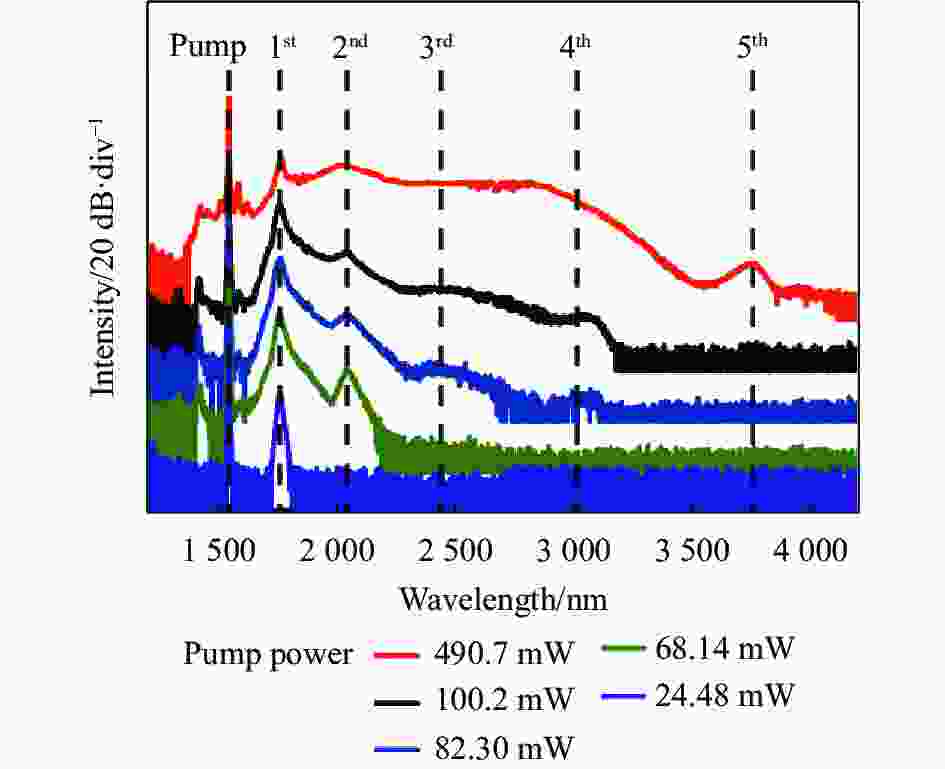
Figure 19. Experimental results of fifth cascaded Raman shift[89]
为了验证该玻璃光纤在拉曼光纤放大器研制方面的应用潜力,笔者研究组搭建了如图20所示的级联拉曼光纤放大器实验装置[90],采用1550 nm纳秒激光器作为泵浦源,实验室自制的1765.0 nm和2049.2 nm连续掺铥光纤激光器作为信号源,芯径~5 μm的氟碲酸盐玻璃光纤作为拉曼增益介质。图21分别给出了一级、二级、三级拉曼光纤放大器输出功率和转换效率随泵浦光功率的变化。使用1765.0 nm光纤激光器作为信号源时,获得了净增益为22.6 dB、光光转换效率为36.76%的拉曼激光放大,放大后的激光输出功率为190.9 mW,脉冲宽度为3.42 ns。使用1765.0 nm和2049.2 nm光纤激光器共同作为信号源时,获得了净增益为21.3 dB、光光转换效率为24.24%的级联拉曼激光放大,放大后的激光输出功率为135.35 mW,脉冲宽度为3.36 ns。随后,将氟碲酸盐玻璃光纤的长度增加至10 m,获得了三级级联拉曼放大。注:在光纤内,放大的1765.0 nm和2049.2 nm激光由于非简并四波混频的作用,产生了工作波长位于2442.6 nm的斯托克斯光,该激光联合1765.0 nm和2049.2 nm激光共同作为信号源,构成了三级级联拉曼光纤放大器。由于四波混频产生的2442.6 nm激光能量较弱,最终放大的三级拉曼斯托克斯光的输出功率仅为18.84 mW,相应的光光转换效率为3.86%。

Figure 20. Experimental setup of cascaded Raman amplifier based on fluorotellurite fiber[90]

Figure 21. The output of cascade Raman amplifier powers and corresponding conversion efficient versus the launched pump power[90]. (a) First-order amplifier; (b) Second-order cascaded amplifier; (c) Third-order cascaded amplifier
在中红外拉曼孤子激光光源方面:2018年,笔者课题组利用工作波长为1 960 nm的飞秒光纤激光器泵浦一段具有双零色散波长的氟碲酸盐玻璃光纤,获得了波长调谐范围覆盖1.96~2.82 μm的拉曼孤子激光输出[91]。2022年,电子科技大学Chang等利用工作波长更长的2.8 μm飞秒激光泵浦氟碲酸盐玻璃光纤,将相应中红外拉曼孤子激光的工作波长拓展至~3.17 μm,结果如图22所示[24]。实验中泵浦种子光源由掺铒ZBLAN锁模光纤激光器提供,其工作波长为2.8 μm。泵浦脉冲光源在放大器中的掺铒ZBLAN光纤中首先进行了预频移,当放大器泵浦功率为5.55 W时,孤子频移至2910 nm,此时放大器总输出功率为773 mW,脉冲宽度为~200 fs。孤子脉冲在氟碲酸盐玻璃光纤中产生进一步频移,最终获得波长调谐范围覆盖2.8~3.17 μm的中红外拉曼孤子激光光源,其中3.17 μm孤子激光的平均输出功率为38.9 mW,脉冲能量为0.744 nJ,相应的转换效率为26%。数值模拟结果显示,利用该氟碲酸盐玻璃光纤作为非线性介质可将拉曼孤子激光的工作波长拓展至~3.831 μm,如图23所示[23]。
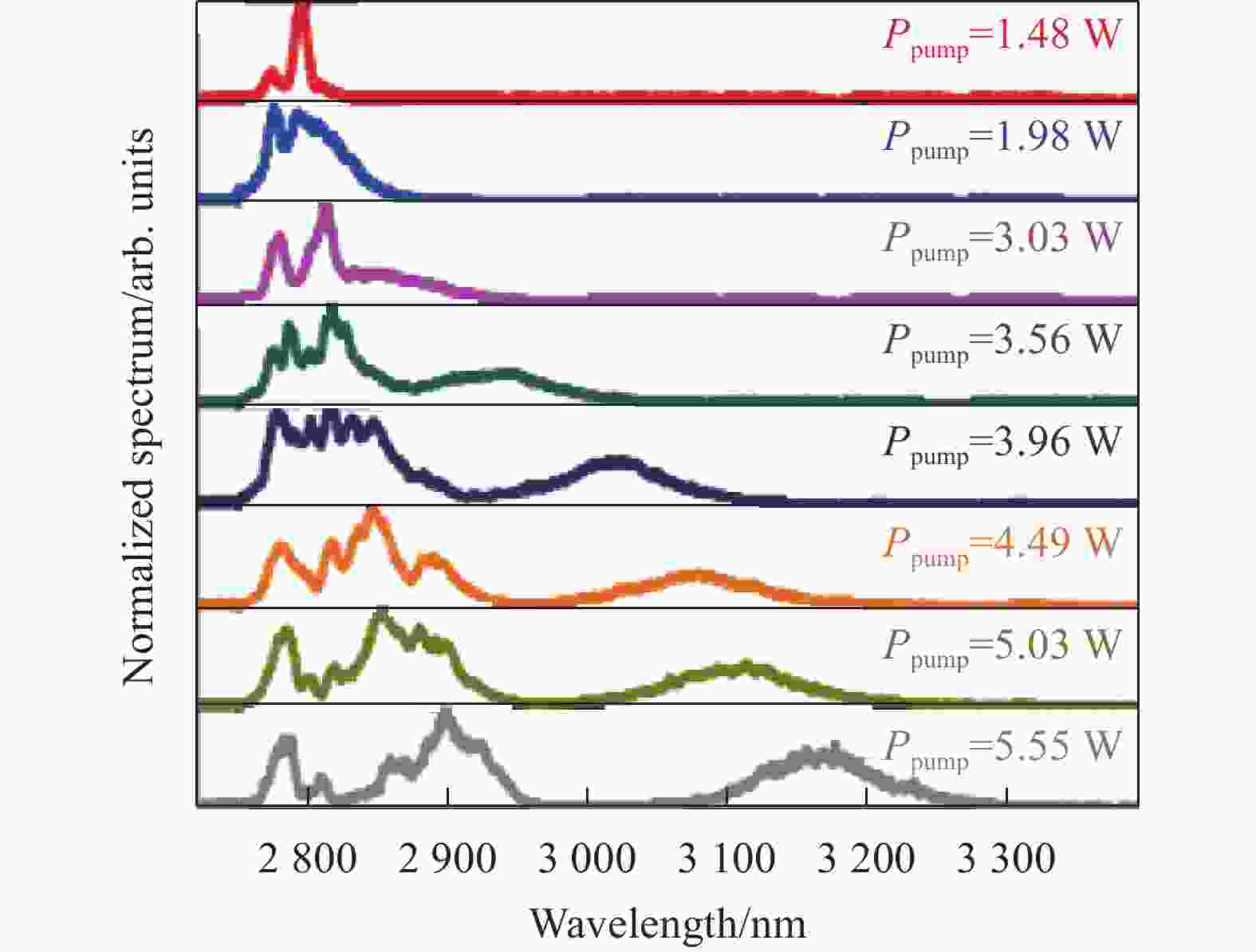
Figure 22. Dependence of the spectrum from the fluorotellurite fiber on launched pump power in the amplifier[24]
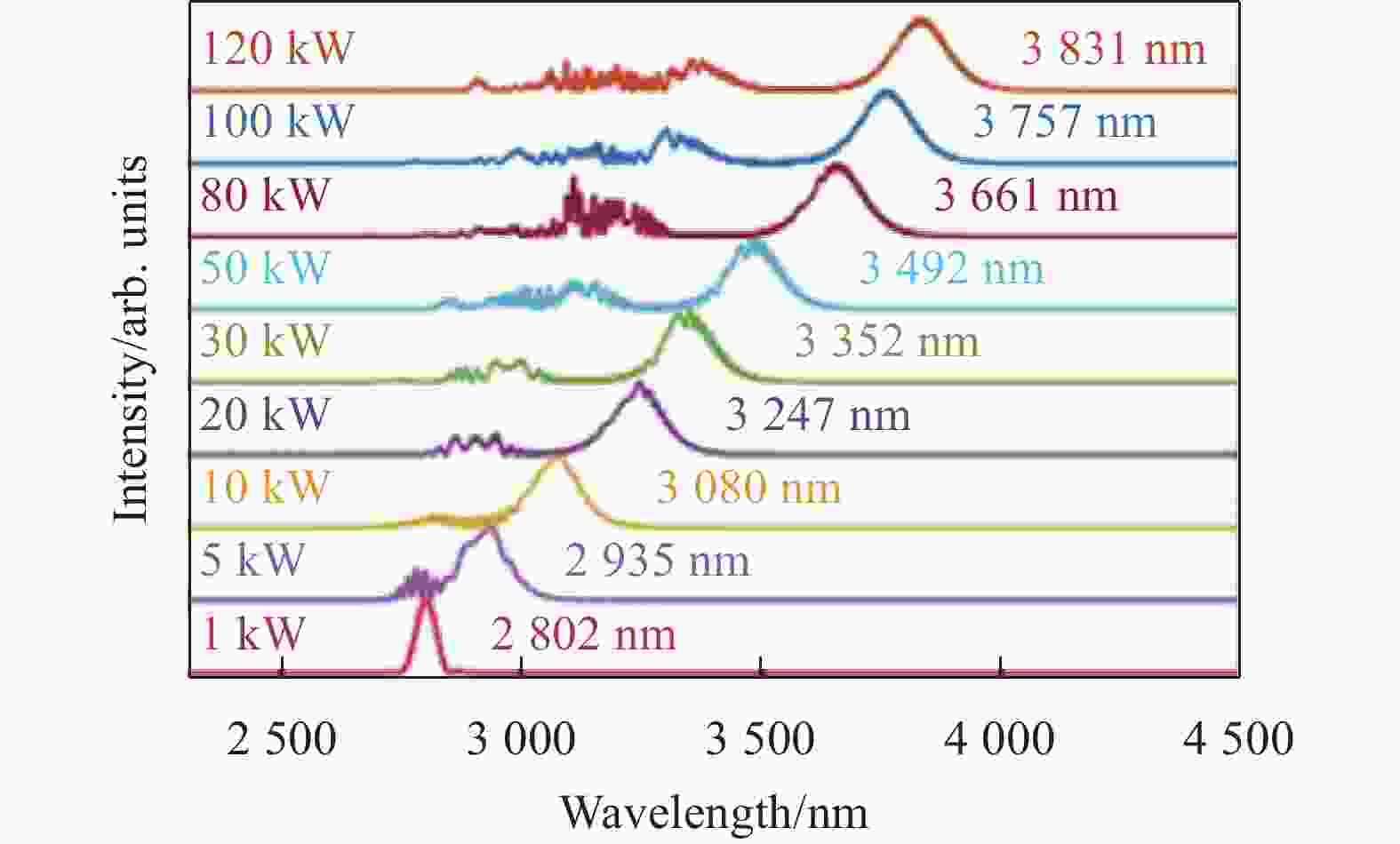
Figure 23. Simulation results of the spectra of the output pulses when pumping at 2.8 μm[23]
对于双两个零色散波长光纤,当拉曼孤子红移至光纤的第二零色散波长处时,拉曼孤子将停止频移并在长波区产生红移色散波,其频率由光纤的第二零色散波长位置决定。因此,原则上利用色散精密调控的光纤作为非线性介质,通过孤子自频移效应和红移色散波的产生可获得任意波长处的中红外激光光源。为了验证上述思想,笔者课题组设计并制备了具有双零色散波长的色散调控氟碲酸盐玻璃光纤,其数值孔径为1.1,芯径为2.6 μm,零色散波长分别为1.328 μm和3.551 μm,如图24所示[92]。
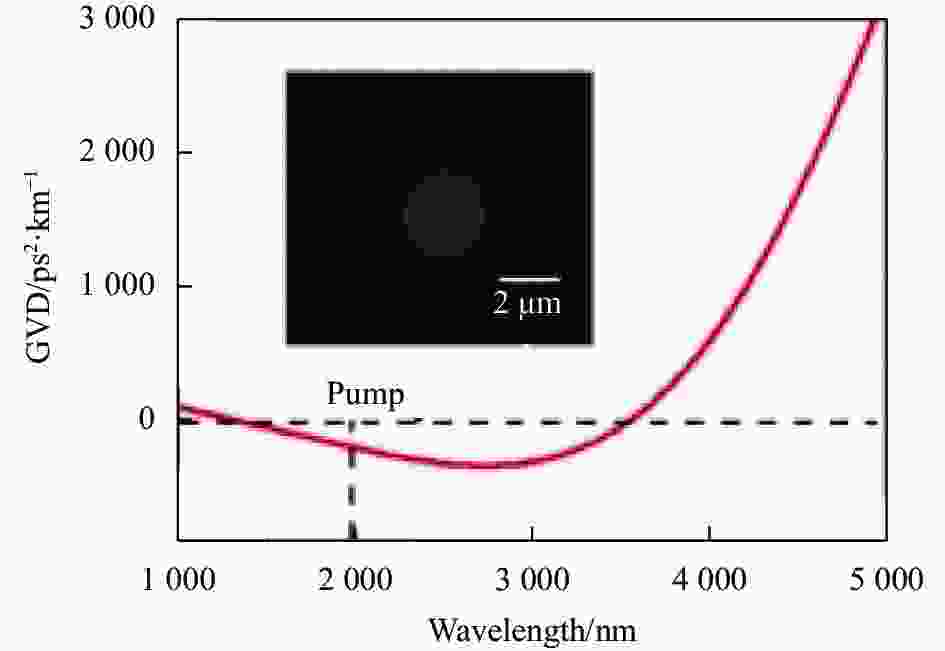
Figure 24. Group velocity dispersion curves of LP01 modes propagating in the fulorotellurite fibers. Inset: cross-sectional scanning electron micrograph of fluorotellurite fibers[92]
利用该光纤作为非线性介质,利用工作波长为1.98 μm的飞秒激光器作为泵浦光源,搭建了实验测试装置,获得了输出波长位于~4 μm的色散波光源,如图25所示。实验中测得的总输出功率为0.573 W,其中波长4 μm处的色散波的平均功率为~12 mW,脉冲能量为0.24 nJ,相应的转换效率为~1.2%。数值模拟结果显示,由于泵浦光波长位于该光纤的反常色散区,首先产生高阶孤子,高阶孤子在高阶色散的微扰作用下劈裂出基阶拉曼孤子,进而产生拉曼孤子自频移效应。当拉曼孤子频移至光纤的第二零色散波长处时,发生孤子自频移抵消效应并产生波长为~4 μm的红移色散波。此外,笔者课题组还基于自制氟碲酸盐玻璃光纤,先后研制出输出光谱范围覆盖0.6~5.4 μm和输出平均功率为25.8 W的中红外超连续光源[88,93]。上述研究结果表明,该氟碲酸盐玻璃光纤在实用化高功率中红外拉曼激光光源研制方面具有十分巨大的应用潜力。通过进一步优化泵浦激光和氟碲酸盐玻璃光纤参数,有望实现输出功率为数十瓦量级甚至百瓦量级的中红外拉曼激光光源。
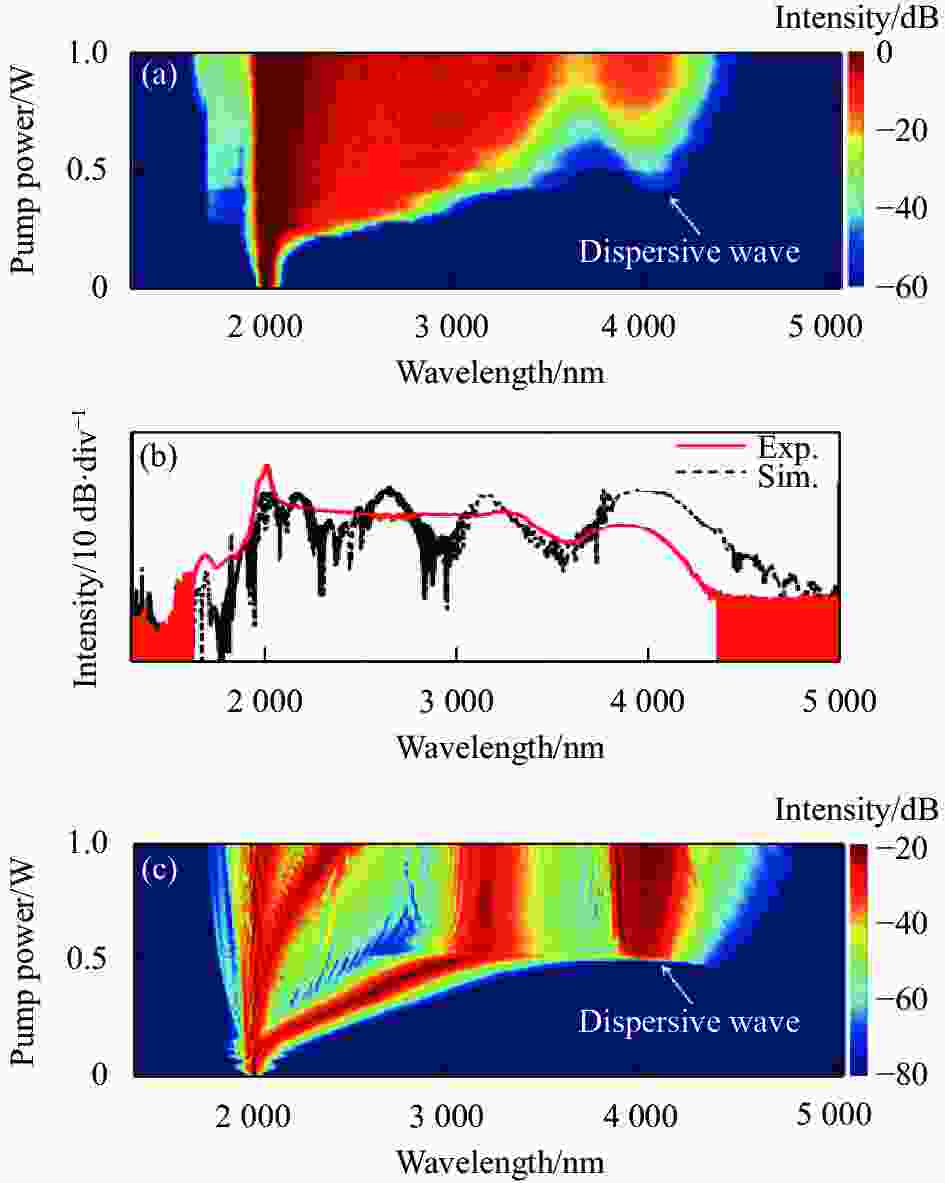
Figure 25. Experimental results[92]. (a) Measured spectral evolution of output signals from a 1 m long fluorotellurite fiber with the average power of the 1.98 μm femtosecond laser; (b) Simulated and measured spectra output from the fluorotellurite fiber for a same average pump power of ~1 W; (c) Simulated spectral evolution of output signals from a 1 m long fluorotellurite fiber with the average power of the 1.98 μm femtosecond laser
-
高功率中红外光纤激光光源在前沿科学研究、空间光通信、医学诊断与治疗、环境污染监测和光电对抗等领域有着重要应用。利用光纤中的受激拉曼散射效应是实现高功率中红外激光输出的有效途径。目前,基于硫系玻璃光纤、氟化物玻璃光纤和碲酸盐玻璃光纤等中红外光纤材料,分别实现了工作波长位于3.77 μm的拉曼光纤激光器,平均输出功率为3.7 W的2231 nm拉曼光纤激光器和波长调谐范围覆盖2~4.3 μm的拉曼孤子激光光源。笔者课题组研制出一种热学和化学稳定性好、激光损伤阈值高和拉曼频移量大的氟碲酸盐玻璃光纤,进一步利用其作为非线性介质,先后实现了级联拉曼散射、级联拉曼光纤放大器、波长调谐范围覆盖1.96~2.82 μm的拉曼孤子激光以及波长为~4 μm的红移色散波。
Progress on mid-infrared glass optical fiber materials and Raman laser source (invited)
doi: 10.3788/IRLA20230228
- Received Date: 2023-04-18
- Rev Recd Date: 2023-05-09
- Publish Date: 2023-05-25
-
Key words:
- Raman laser /
- infrared and far-infrared lasers /
- fiber lasers /
- fiber materials
Abstract:



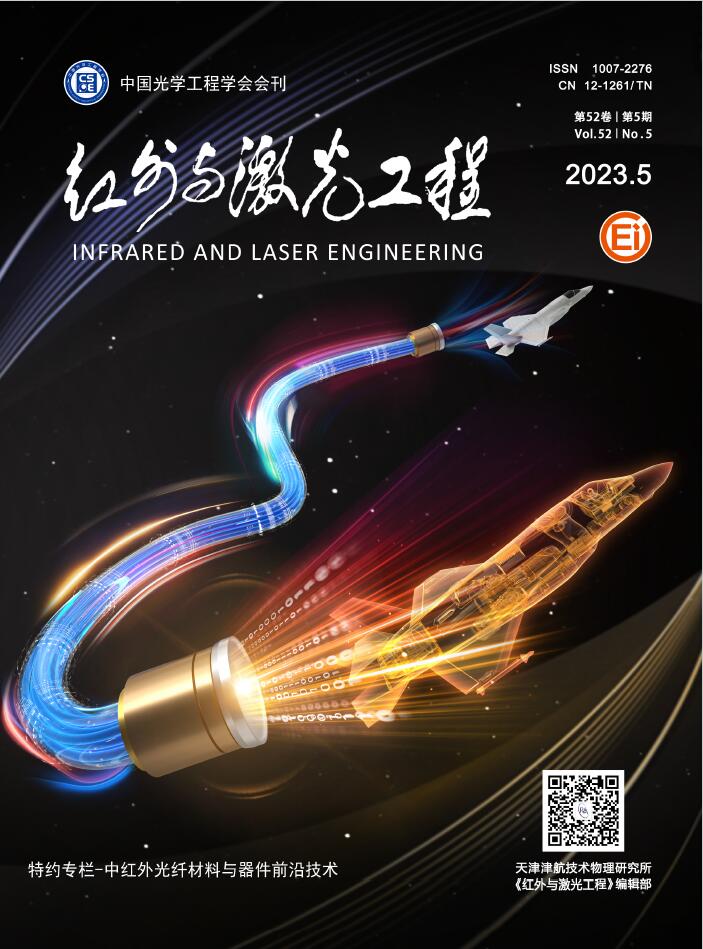













 DownLoad:
DownLoad:


